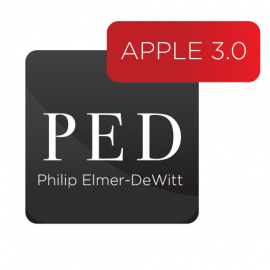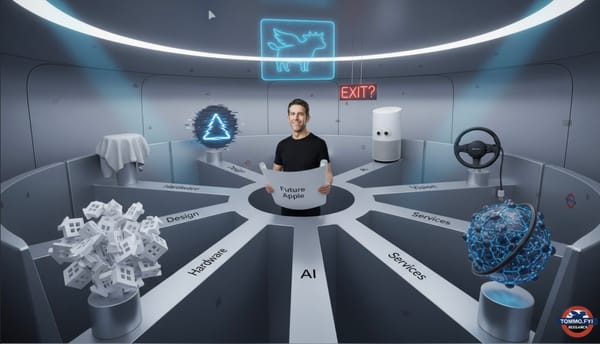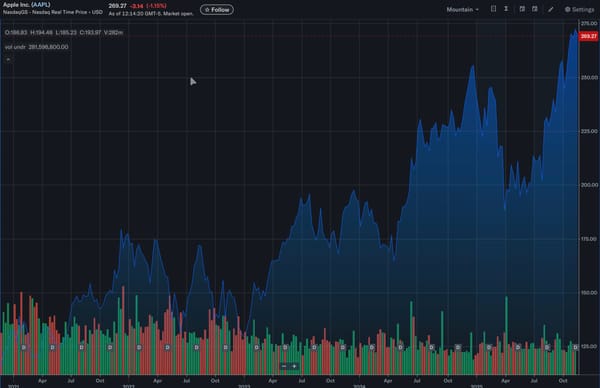Perplexity: The OS 9-to-OS X Moment for Apple AI, Why “Real Artists Ship” Still Matters, How Apple Could Own AI by this Christmas—and Hit $400 by 2027
Buying Perplexity gives Apple an instant AI OS, a live interface, and reclaims its instinct. It bridges FMF, replaces Google’s crutch, turning Siri from joke to conductor. Skip 18 months of build, own the narrative—and make $400 AAPL feel underpriced by 2027. The shortcut—shipping—is the product.
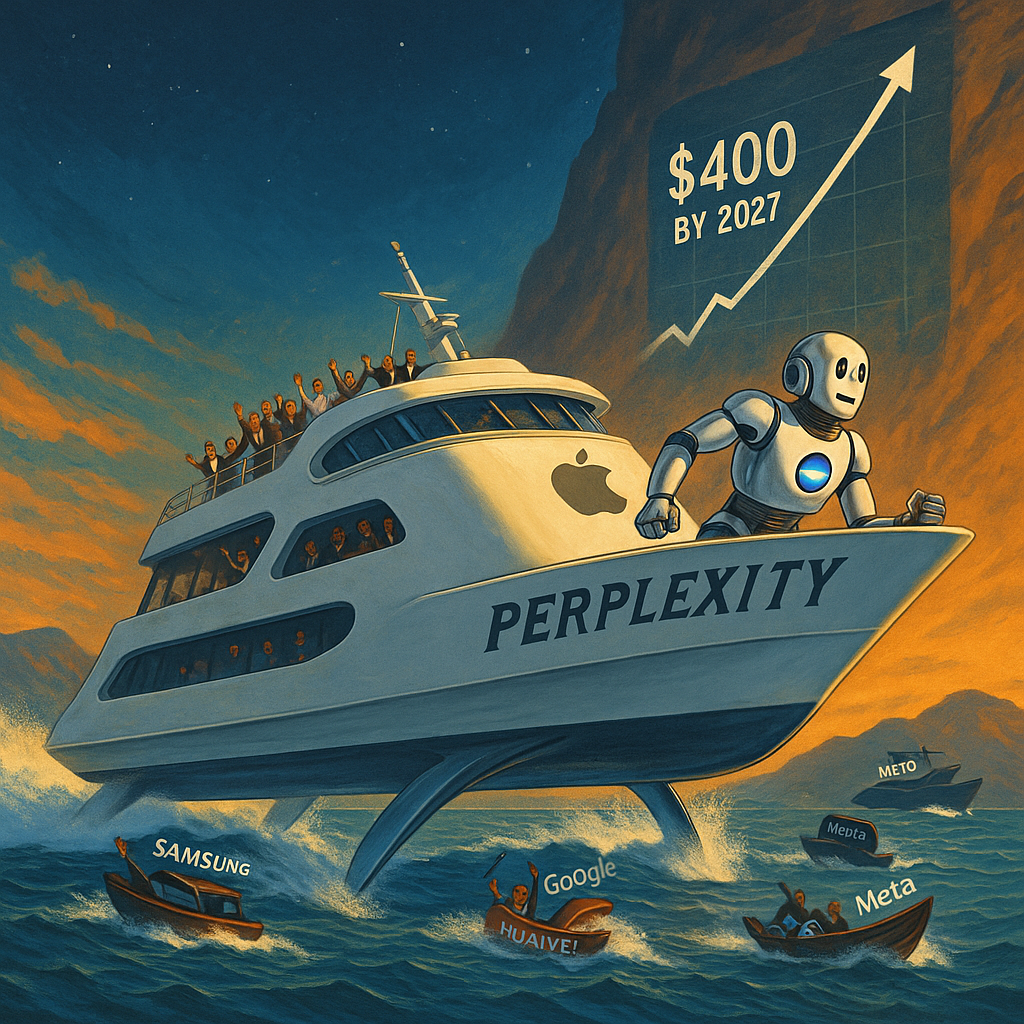
On Friday 20th June 2025, Reuters and Bloomberg issued reports that Apple’s senior team had held serious internal discussion about acquiring Perplexity, supposedly to improve Safari Search and acquire AI talent. I argued for the acquisition, but against the purported rationale as led by the reporters.

Saturday’s Dive Into Friday’s Reuters Report About An Apple Bid For Perplexity
I was already working on a story about Perplexity as part of a trilogy of Apple and AI articles I had planned, so I hastily re-ordered their publication to bring this one to the fore. Given more time, it would be more concise and more condensed, but this isn’t a “Power On“ digest aimed at Twitter/X readers. It’s deep analysis and futurism and I’ve taken all the time I feel a proposition this controversial to some, and exciting or disdainful to others, deserves. The result may seem a bit raw in places but with time of the essence, and as a famous former Apple founder once said, “Real Artists Ship,“ so shipping I am - warts and all - and if you have anything to say, please, put it in the comments. I will answer each and every question or remark
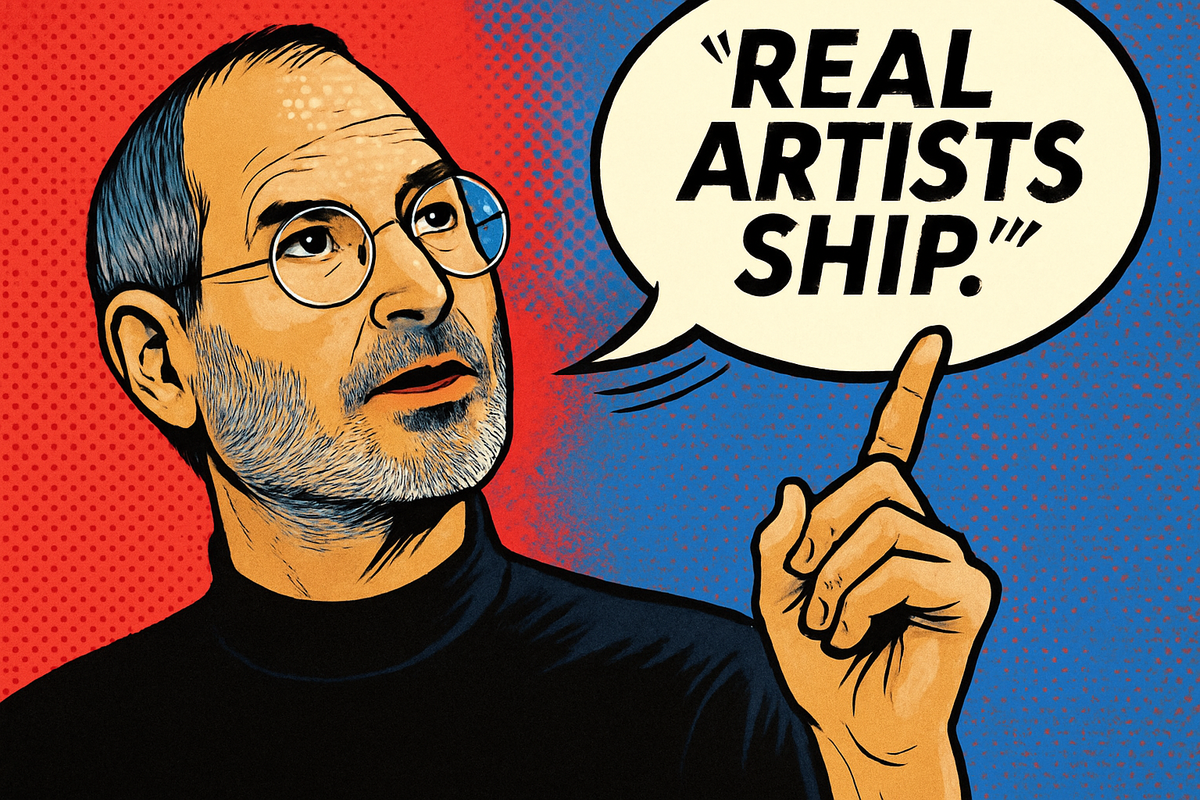
Waiting for Godot is for perfectionists who don’t know when to compromise.
ABSTRACT:
I’ve been thinking about Perplexity hard and I’ve changed my mind. No hopium. No hype. Just… clarity. I mentioned before that I was working on a few AI pieces off the back of WWDC, building from my “SenseOS” concept—a post-Siri, post-WWDC-2024 concept operating layer Apple could (and should) be building.
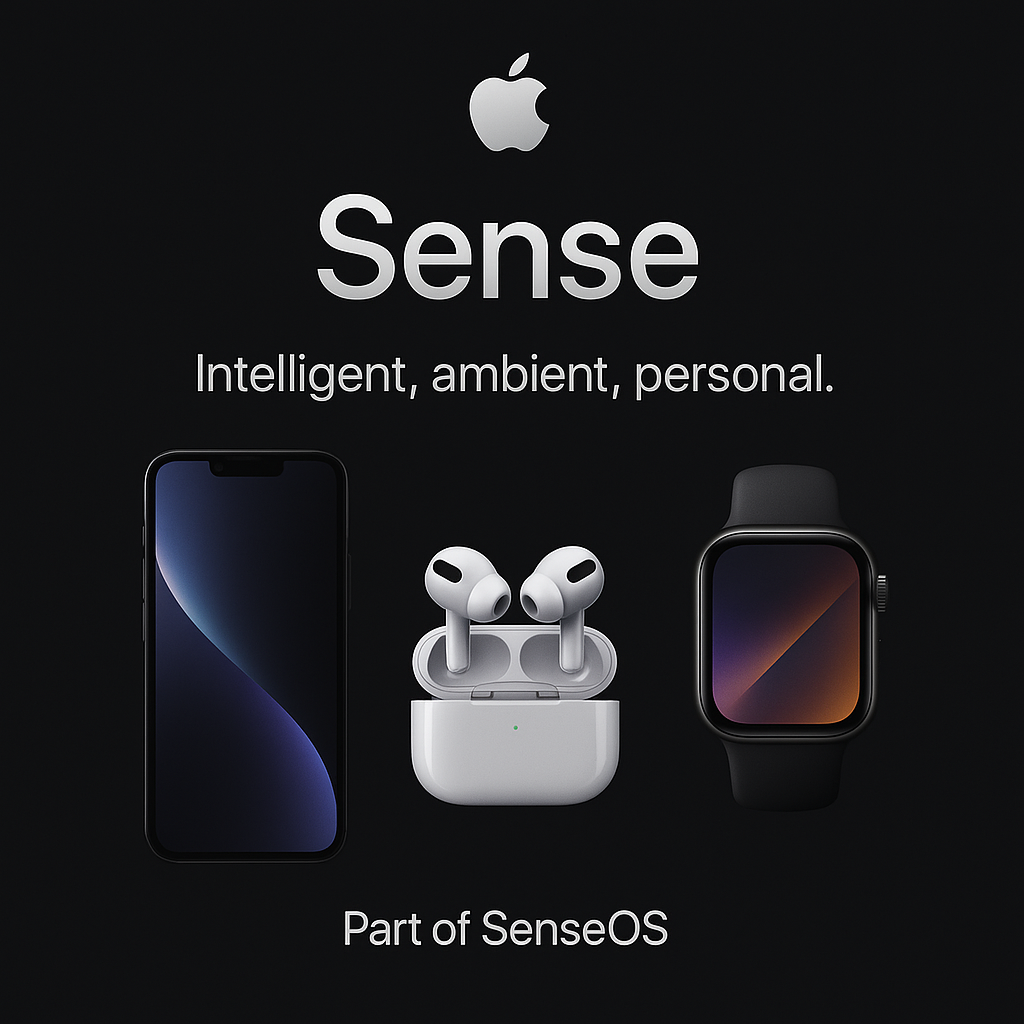
My pre-WWDS SenseOS Concept: It Is Possible To Anticpate What Apple “Should” Do.
But this week something clicked. A lightbulb moment. One that made everything else I’d been observing fall into place. There was a big discussion over this on Apple 3.0 (paywall):

Saturday, 21st June’s Discussion of the subject over on Apple 3.0
Even Mark Gurman from Bloomberg is trying to get his oar in, releasing a rather brief bullet point article behind his Bloomberg paywall “Mark Gurman’s Sunday Ablutions Thought ’O The Day.” You can pay to read and “Jump the Line” for $300 a year for a regurgitation of the previous week’s various Apple forum posts:

Or you can deep dive here for free. Although for coffee dollars the the tips button at the end looks like this…
…but of course, no pressure. None at all. Certainly not $35.99 a month.
Quick Digest & Cheat Sheet:
Firstly though, a digest: what this article summarises, in case you want to skim a few facts and get the gist of the story. You won’t want to miss the logic in the full article if you want a deep dive and “the money” message, but If you’re short on time, this is the essence of it distilled in terms of outcomes.
If you’re ready for the full dive, keep reading. The devil’s in the details—and this is just the apéritif, not the main course for a short 3 minute read as a primer to the main course..
Apple doesn’t need to buy Perplexity. It didn’t need to buy in iTunes. Or the original clickwheel iPod interface. But God only knows what would have happened to Apple’s surging growth if it hadn’t. But if it did, it would be admitting and owning what it’s lost:
The ability to ship instinct, and the ability to take a market by storm, not by politely knocking on the door gently for the yet another 12 months. The most powerful product Apple could ship… is humility and action, not another year or two of slowly building a bridge to somewhere that’s constantly on the move, and end up with a bridge whose destination won’t wait.
What follows is a strategic anatomy:
• Why Siri failed, and keeps failing
• Why Perplexity accidentally built what Apple was too proud to try
• Why FMF is a theory—and Perplexity is already live
Why orchestration—not a soloist—is what the Apple ecosystem actually needs.
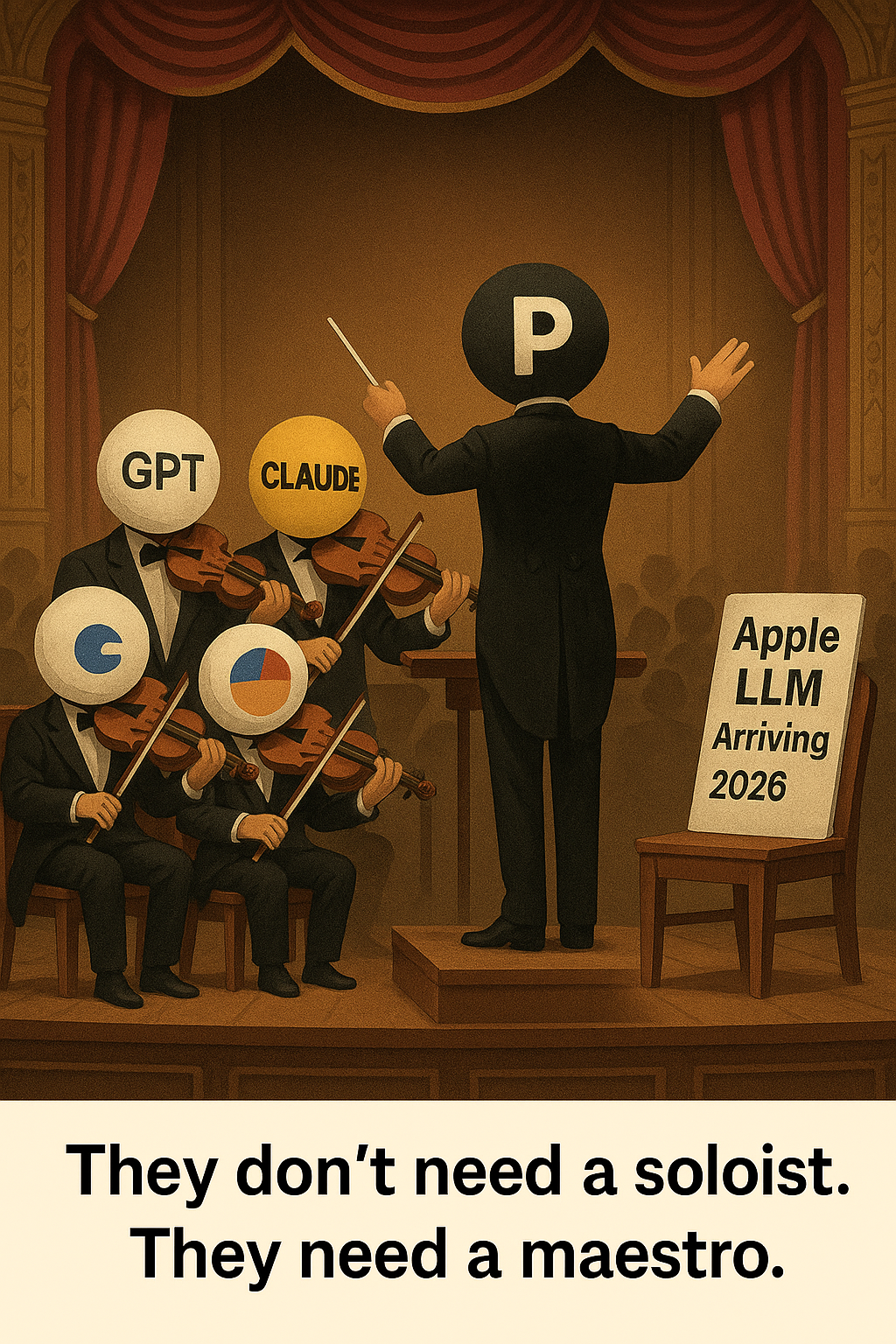
And what’s at stake:
• The bridge from “Now” to 2026
• The meaning of “Apple Intelligence” when Siri still apologises
• The difference between making a chatbot—and making sense
Some readers will want the whole map. Others just the coordinates. This “Cheat Sheet” digest is for the latter.
For a fully informed read, I highly recommend reading the digest to put this proposal in perspective, reading the article, and then returning to the Digest to embed it all in the context of having read the detail.
The comments section is there for a reason. Comment, argue, disagree, ask questions. I’ll answer in close to real time, or of there are substantial deep questions I’ll ship a follow-up addendum article.
Key Benefits to a Perplexity Bid
Boom. Here you go. The “Quick Digest” of the full case which follows, that integrating Perplexity could position Apple as the industry standard for AI-driven cross-platform communication. I think this makes for a strong, multifaceted, and well-supported argument by both strategic logic and current market dynamics.
Strength of the Argument, Risks Acknowledged
1. Strategic Fit and Historical Precedent
The argument draws a parallel to Apple’s acquisition of NeXT in the late 1990s, which provided the foundation for OS X and catalysed Apple’s resurgence. In the same way, Perplexity is positioned not as a mere product, but as a ready-made orchestration layer—akin to a “nervous system” for Apple’s AI ambitions—that could be integrated immediately, leapfrogging years of in-house development delays.
This is not just about plugging a technology gap, but about importing a mature philosophy and engineering team that aligns with Apple’s privacy-first, user-centric ethos.
2. Technical and Ecosystem Advantages
Perplexity is model-agnostic and API-driven, already orchestrating among best-in-class LLMs (e.g., GPT-4, Claude, Mistral etc) and delivering a clean, citation-backed, privacy-aware user experience. This makes it uniquely suited to serve as the connective tissue for Apple’s Foundation Model Frameworks (FMF) and broader AI vision.
Its architecture allows Apple to swap in its own models over time, ensuring long-term control while delivering immediate value.
3. Cross-Platform and Developer Opportunity
The proposal to make Perplexity’s AI orchestration available as a service to non-Apple device users—much like Apple Music or iCloud—would extend Apple’s reach and services revenue, echoing the iPod/iTunes strategy that fuelled Apple’s dominance in the early 2000s.
By exposing carefully managed FMF APIs to external developers (while maintaining strict privacy controls), Apple could make its AI “plumbing” the default for any software company wanting to interact with Apple users, thus setting an industry standard for secure, privacy-centric AI integration.
4. Market Timing and Competitive Pressure
Apple’s dependency on Google for search is both a financial and strategic vulnerability, especially as antitrust pressures mount and competitors like Samsung and Meta aggressively pursue similar AI partnerships.
Perplexity’s rapid growth and traction (hundreds of millions of monthly queries, strong Gen Z adoption) mean that integrating it now could allow Apple to capture a new generation of users and developers, rather than ceding them to Google, OpenAI, or Samsung. Samsung and others would be locked out completely.
Apple would dominate the AI ecosphere without regulatory problems, because it wouldn’t be leveraging access to its own walled garden alone but – as with the iTunes model – embracing a platform agnostic approach, while re-launching the switch strategy of the “Get a Mac” campaign but for the current generation.
5. Addressing the “Wrapper” Critique
This proposal acknowledges that Perplexity is not an LLM creator but an orchestrator—a “wrapper”—and turns this into a strength. Apple doesn’t need another LLM; it needs a robust, privacy-aligned orchestration layer that can integrate multiple models, including its own, and deliver a seamless user experience1.
The risks of integration, privacy, and IP are real but are presented as manageable within Apple’s proven playbook for hardening and aligning acquisitions to its standards.
6. Economic and Execution Logic
The financial argument is pragmatic. I’ve balanced cost and ROI, both short term and long term:
Apple’s cash reserves and history of transformative acquisitions (Beats, NeXT, Shazam) make a $14–30B investment in Perplexity a strategic, rather than purely speculative, move.
It is a move to boldly lay claim to the sector and dominate it, not iteratively, but ruthlessly. The way Apple used to operate, and which laid the path for its successes in the past.
The urgency is underscored by the risk of Perplexity aligning with competitors (e.g., Samsung), which could lock Apple out of a critical AI partner and force it to play catch-up for years.
7. Vision and Industry Impact
The vision is for Apple to not only catch up in AI, but to set the standard for how AI-driven communication, search, and assistants should work across platforms, with privacy and user trust at the core.
By making Perplexity’s orchestration the industry default—accessible to all platforms but with deeper integration and privacy for Apple users—Apple could own the “plumbing” of the next era of software with AI hooks, much as it did with iTunes and the App Store.
8. Coherence and Thoroughness
This case is coherent, weaving together technical, strategic, financial, and historical threads into a unified argument.
It is thorough in addressing both the opportunities (talent, technology, user experience, market share) and the risks (integration, culture, IP, regulatory scrutiny), and proposes concrete solutions for each1.
9. Potential Weaknesses and Realism
The integration risks, especially around talent retention and aligning Perplexity’s open, API-driven model with Apple’s walled garden, are significant and should not be underestimated.
The “industry standard” vision depends on Apple’s willingness to open its APIs to external developers and maintain cross-platform availability, which would be a cultural shift for Apple but is argued as both feasible and necessary for market dominance.
Summary of Investment Thesis for AAPL Shareholders present and future:
An Apple acquisition of Perplexity would fundamentally reshape investor attitudes toward the company’s innovation pace—potentially transforming perceptions from “cautious and slow” to “bold and decisive,” while addressing years of mounting skepticism about Apple’s AI execution. Enough of “Apple sticking to its knitting.”
Current Investor Sentiment: Frustration and Doubt
Perceived AI Lag: Investors and analysts have repeatedly flagged Apple’s deliberate, shoe-lace tripping slow-moving approach to AI as a risk. Recent earnings calls and analyst notes highlight delays in Siri upgrades and AI feature rollouts, with significant improvements not expected until 2026 or even 2027. This has led to market underperformance compared to AI-hyped peers and a sense that Apple is “playing catch-up.”
Complacency Concerns: There’s a growing impatience among shareholders, who see Apple’s rivals (Microsoft, Meta, Google) aggressively monetising and shipping AI products, while Apple’s own efforts are largely under-the-hood or classed as “vapourware.”
Equally there is growing disinterest in Apple AI amongst consumers, sold on whatever they think it is with no clear vision articulated (in 2024, or in 2025) yet, making entropy and disinterest in the brand a growing creeping cancer and likely to impact future upgrade cycles. This move would refocus consumer on Apple with laser-like precision, with not an iterative slow drip-drip release of features, which has little impact, but a genuine “boom” moment, which would be market defining and trend settting.
Strategic Uncertainty: The looming threat of losing the $20B Google search deal, coupled with the risk of being leapfrogged in the next tech paradigm, has led to calls for a more urgent, visible pivot.
How a Perplexity Acquisition Would Change the Narrative
1. Signals a Generational Shift in Innovation Pace
From Incremental to Transformational: Acquiring Perplexity would be Apple’s largest-ever deal, echoing the historic NeXT acquisition that rebooted Apple’s fortunes in the late 1990s. It would be seen as a generational pivot—Apple “buying speed” to leapfrog years of internal development and ship a working, consumer-facing AI product almost immediately.
“Real Artists Ship” Moment: The move would counter the narrative of endless perfectionism and delays, instead demonstrating that Apple is willing to act decisively when the stakes are high4. Investors would see this as Apple rediscovering its ability to “just ship”—a quality that defined its greatest product cycles.
2. Restores Confidence in Apple’s Competitive Edge
Closes the AI Gap: By integrating Perplexity’s model-agnostic AI orchestration and search platform.
Talent and Technology Infusion: The acquisition would bring in a world-class AI team and a proven product, addressing concerns about Apple’s ability to recruit and retain top AI talent in a fiercely competitive market.
Apple could rapidly match or surpass the AI experiences offered by rivals, restoring faith in its ability to lead, not follow, in key technology shifts.
3. Reframes Apple’s Risk Appetite and Strategic Vision
Boldness Over Caution: Investors have criticised Apple for playing it safe and relying on incrementalism.
Defensive and Offensive Logic: The acquisition would be seen as both a hedge against losing Google search revenue and an offensive move to define the future of AI-driven search and assistance, rather than being boxed in by partners or regulators.
A Perplexity deal would be interpreted as a rare, bold bet—reallocating capital from buybacks to growth and innovation, which growth-oriented investors crave.
4. Creates Immediate and Visible Product Impact
Accelerated AI Rollout: Instead of waiting for Apple’s in-house AI stack to mature, investors would see the potential for Perplexity-powered features to be integrated into Siri, Safari, and system-wide search in months, not years—potentially in time for the next iPhone cycle.
Cross-Platform Monetisation: This model offers the prospect of delivering Perplexity as a subscription service to non-Apple users through an Apple Services bundle.
Opening up limited and privacy sensitive APIs for third-party developers, would signal a new era of platform-agnostic services revenue—expanding Apple’s addressable market and appealing to Wall Street’s appetite for growth.
5. Catalyses a Rerating of Apple’s Innovation Premium
Stock Price Upside: Multiple analysts have already suggested that a successful AI pivot—especially one as visible as acquiring Perplexity—could drive a significant stock rally, with price targets raised by as much as 20-30% on the expectation of renewed growth and market leadership. And this would be fast, rapid, and lay the groundwork for an increased confidence in the return of rapid growth.
With a forward multiple back into the high 30s providing execution met vision, and real earnings growth back on the table rather than buyback smoke and mirrors, Apple would be the supertanker on hydrofoils, once again.
This Restores Apple’s “Visionary” Status: The move would help Apple reclaim its reputation as a visionary, not just a safe steward of an existing ecosystem, which is critical for maintaining its premium valuation multiple, and indeed increasing it.
6. Potential Risks and Investor Cautions
Execution and Integration: Some investors will remain cautious, noting Apple’s mixed record with large acquisitions (e.g., Siri) and the risk of cultural or technical misalignment. However, this is a risk-on moment once-in-a-generational moment, and past failures need to be a challenge to the company it is prepared to acknowledge the reason for, and instead focus on its past, paradigm shifting successes, including major platform infrastructure changes in the past, all of which have been outstanding success.
Regulatory and Financial Scrutiny: The size of the deal and its impact on Apple’s cash allocation will draw attention, but Apple’s financial strength makes this a manageable risk.
Conclusion
A Perplexity acquisition would send a powerful message that Apple is prepared to move at the speed of the current AI era, not the pace of its past. It would likely reset investor expectations around innovation, catalyse renewed enthusiasm for Apple’s growth prospects, and reestablish the company as a decisive leader in the next wave of technology—transforming skepticism into optimism almost overnight
The overall case is as robust as I can make it. I am open and transparent about my bias for this deal whilst attempting to address the most obvious friction points head on, in attempt to give balance and realism to this proposal: integrating Perplexity would not only fill Apple’s current AI orchestration gap but could allow it to define the standard for AI-driven, cross-platform communication—provided Apple executes with urgency and openness. The argument is grounded in historical precedent, pragmatic about risks, and ambitious in its vision for Apple’s role in the AI era.
The era of AI would redefine and remember it being the resurgence of Apple:
“Apple 4.0,” you might call it.
/end of digest
And now onto the full works.
Apple Needs Perplexity Now: The Full Works
First, some background on Apple, Perplexity, the AI Race: Unpacking the Acquisition Buzz. Why Apple’s AI future might echo its greatest pivot—and why it should.
From MacOS to Perplexity (via Windows 95): The 30-Year Lesson Still being replayed.
Apple’s internal deliberations about potentially acquiring Perplexity AI – a rising AI search startup – have ignited wide-ranging discussion across tech media, investors, and developer communities. Rumours reported on June 20, 2025, by Reuters, CNBC and Bloomberg sparked analysis of what such a deal could mean.
Below, we explore key perspectives grouped by theme – from opportunities and risks to misconceptions, market logic, and even historical echoes of Apple’s past. Throughout, voices from diverse stakeholders (journalists, analysts, developers, and industry insiders) weigh in with candid quotes on Apple’s AI strategy and the Perplexity proposition.
Before we go further, let’s backtrack for a moment, and go back to basics, because the term “AI” means about as much to most people now, as the concept of a “Graphical User Interface” did in 1984 or “Spatial Computing” did in 2024.
Firstly, What Even Is “AI?” (And Why Everyone’s Talking Past Each Other When Trying To Talk About It)
One of the most common misunderstandings in today’s AI debates—especially in Apple’s corner of the tech world—is that people use “AI” to mean five different things… often in the same sentence.
It’s like arguing about a car race when some people are thinking about the tyres, others the dashboard UI, and others still the fuel pipeline architecture under the track.
To untangle that, let’s lay out the real architecture of what people think they’re arguing about:
AI ≠ LLM ≠ Siri ≠ FMF ≠ App
- AI is the broad category—like electricity. It can mean anything from simple decision trees to brain-scale generative reasoning. It’s an idea, not a product.
- LLMs (Large Language Models) are one type of AI: trained on vast text datasets, they can reason, summarise, write, and mimic human-like responses. GPT-4, Claude, Gemini—these are LLMs.
- Siri, by contrast, is not an LLM. It’s a voice interface built on a much older command-and-control logic tree—an “if-this-then-that” butler with an ever-expanding list of things it still can’t do. Apple is (finally) trying to rebuild it using an LLM as the engine.
- FMF (Foundation Model Frameworks) is Apple’s name for the new plumbing underneath Siri and apps. It’s not the model. It’s the routing layer—the middleware that passes context, user intent, and system data between your apps and whatever LLM Apple eventually ships. Think of it as SenseOS Lite: the connective tissue, not the brain.
- Apps (like Notes, Safari, or Shortcuts) are the endpoints—the interfaces you see. They get smarter when you plug them into an intelligent backend (like FMF + LLM) and teach them how to share memory using “AI Agents.”
AI As a City: Who Runs What, Why You’re Still Stuck in Traffic
To understand what Apple’s building—and why it’s not ready yet—you have to stop thinking of “AI” as a single thing. It’s not an app. It’s not a voice. It’s not even a model.
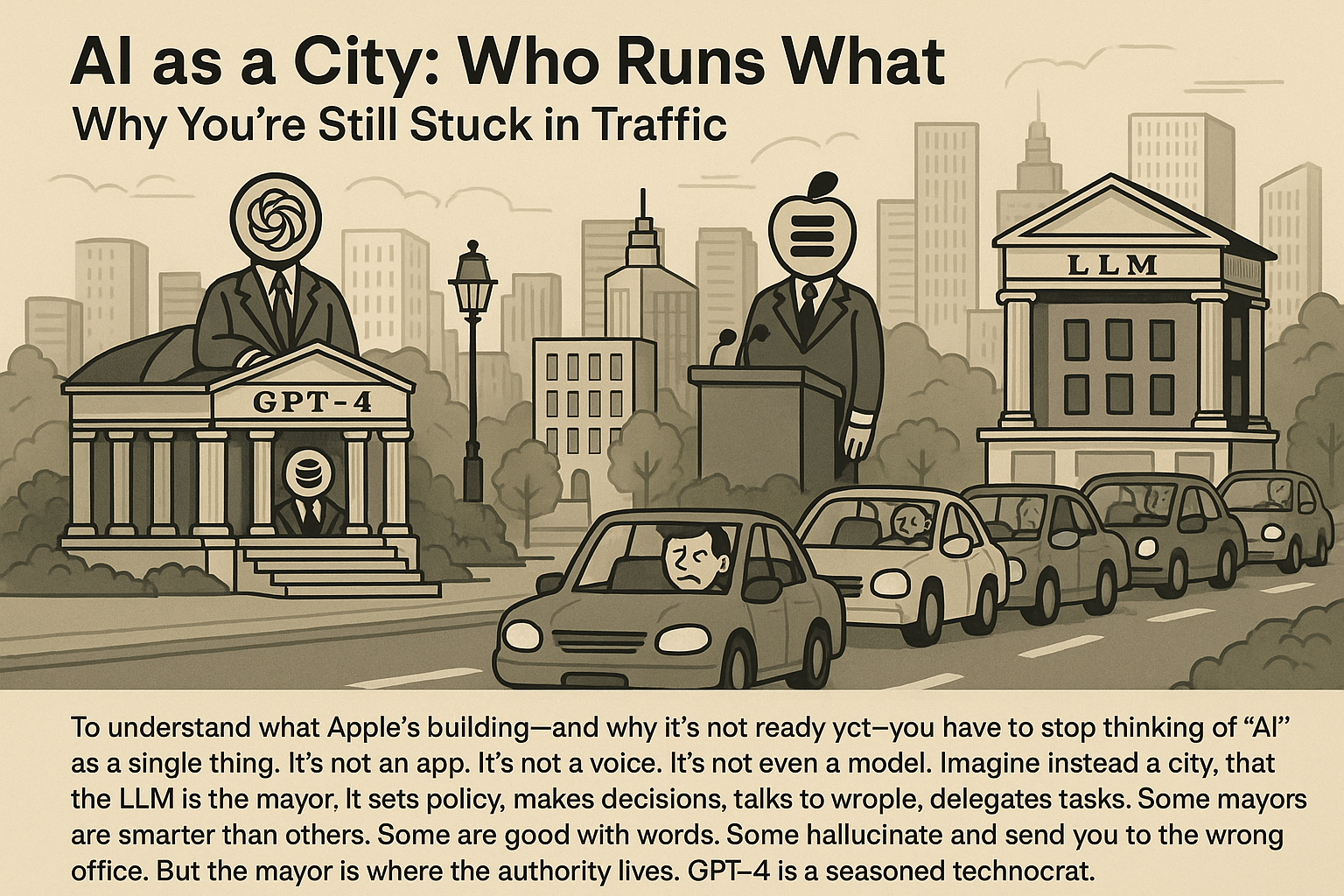
Imagine instead a city, that the LLM is the mayor
It sets policy, makes decisions, talks to people, delegates tasks. Some mayors are smarter than others. Some are good with words. Some hallucinate and send you to the wrong office. But the mayor is where the authority lives. GPT-4 is a seasoned technocrat. Apple’s mayor hasn’t been elected yet.
The FMF is the road and transit system
It’s the routing infrastructure. It knows where people want to go, figures out the best way to get them there, and coordinates between cars, buses, subways, and delivery drones. It doesn’t make decisions. It moves decisions—and data—efficiently.

This is what Apple’s building under the name Foundation Model Frameworks. It’s what I call SenseOS—a kind of nervous system that quietly runs under the surface, coordinating context, memory, permissions, and flow across devices and apps.
Siri is the tour guide
She (no gender presumptions intended before I get a load of TERF abuse thrown at me) used to be charming, but she mostly reads from outdated scripts and doesn’t answer follow-up questions. She’s getting retrained to be smarter—but right now she’s standing awkwardly by the subway map saying “Here’s what I found on the web.” But that could change overnight, if Siri was plugged into Perplexity, instead leaving her “boxed”, not be be opened until around May 2026 according to Apple.
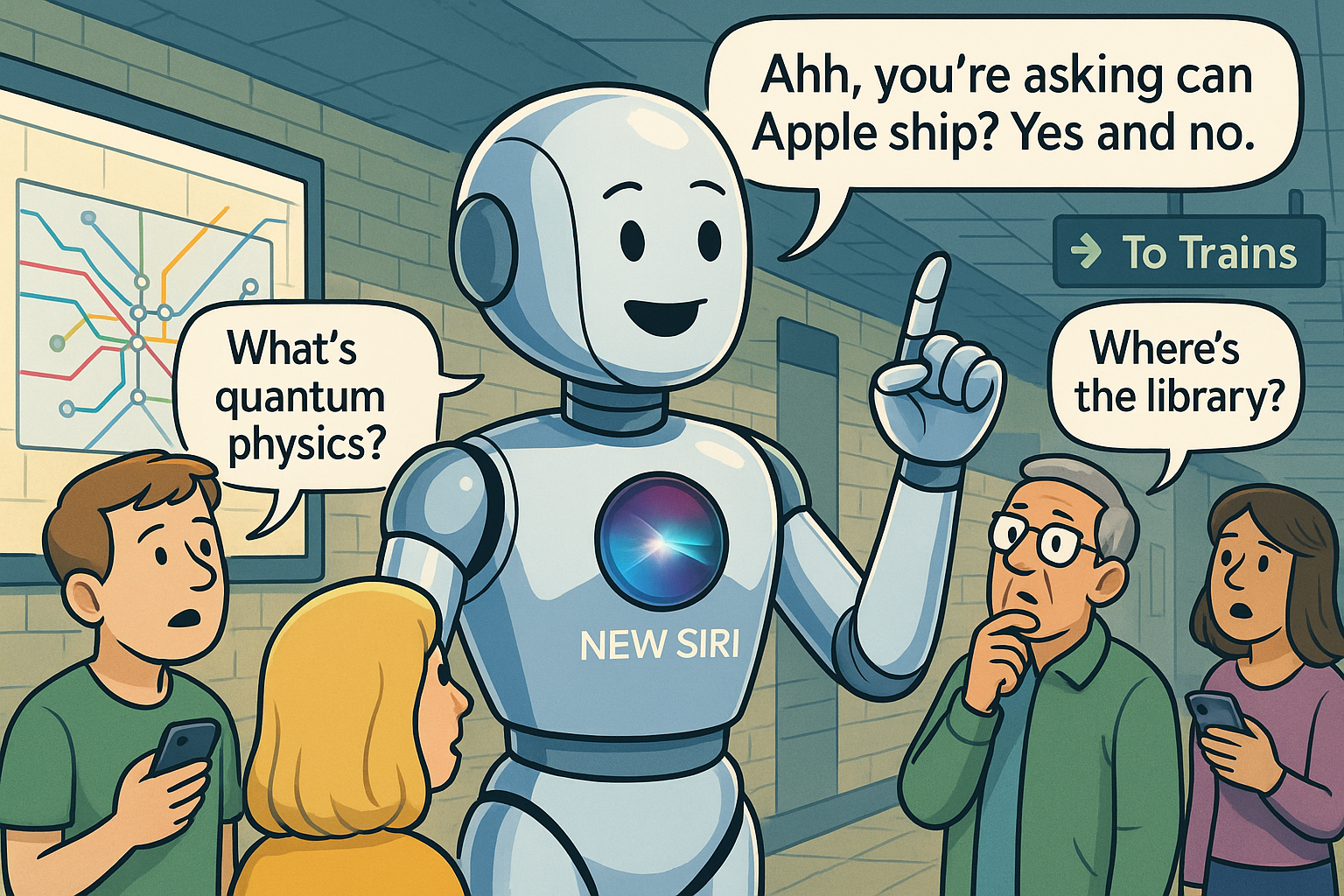
Perplexity is the city manager
It doesn’t try to replace the mayor, it just makes everything work as the executive branch, reaching out for expertise to existing talent pools as and when needed: the LLM’s Perplexity is already so familiar with and has such good integration with.
Perplexity understands your intent, checks with the smartest mayor for that task (GPT, Claude, Gemini…), routes your request through traffic-free infrastructure, and delivers it with citations at lightning speed. It doesn’t just run the city—it clears a path to the answer before you even finish asking the question.
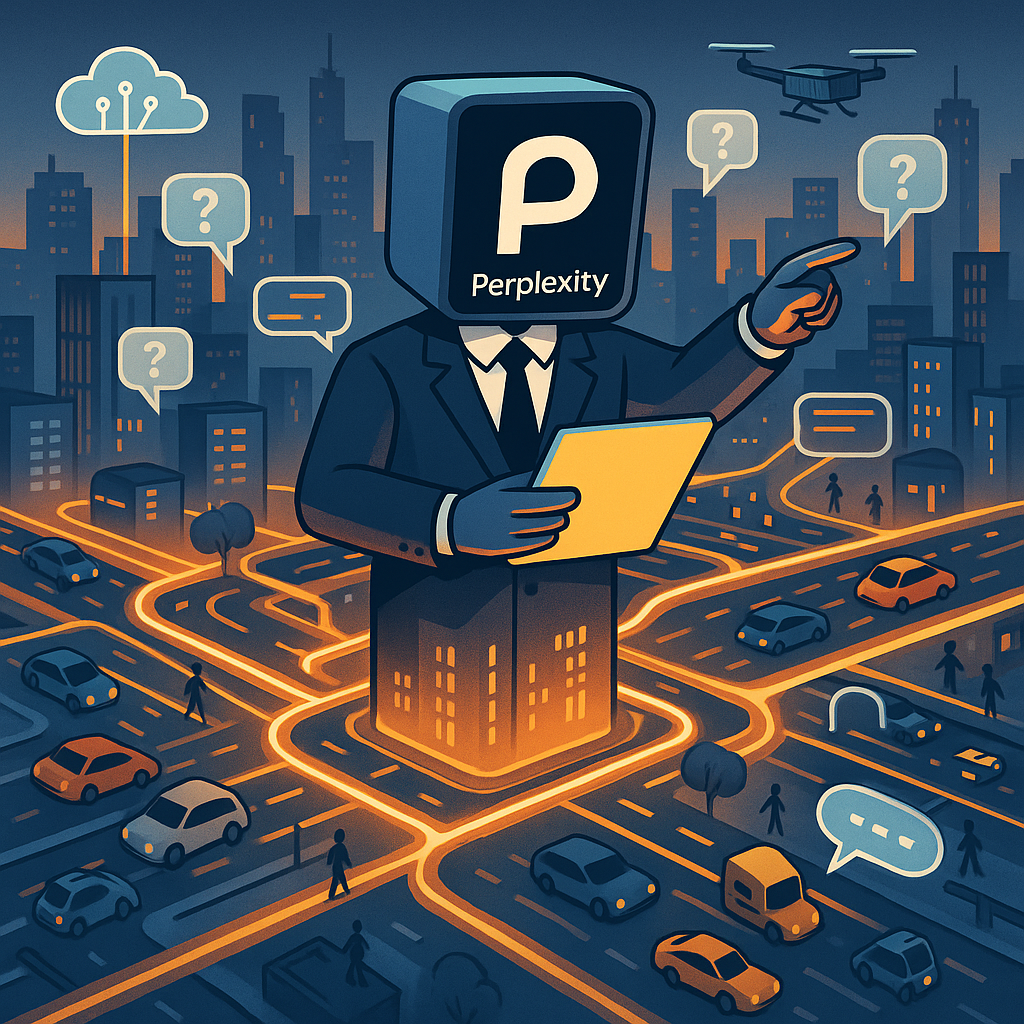
And unlike most city managers, it’s already:
• Built
• Tested at scale
• Privacy-sensitive
• Fluent across systems
Now, here’s the kicker: the subway
Apple’s vision—if they get FMF and their LLM working—isn’t just about smarter roads. It’s about bringing the answer to you, fast, quietly, and wherever you are. That’s what my SenseOS concept was designed to represent.

Instead of users needing to surface-navigate between apps, settings, and search bars, SenseOS would let requests dive underground—cutting through noise, context-switching, and latency. Like a subway of intention: invisible, direct, efficient.
And guess what? Perplexity has already built the first working subway train system which truly functions seamlessly across different networks and ecosystems.
The 30-Year Context: Apple, OS Replacements, Platform Changes, And The Strategic Precedent For Perplexity.
There’s a historical rhyme unfolding.
In the mid-1990s, Apple was floundering. Mac OS had hit a wall. Engineers had attempted various in-house solutions (Copland, Gershwin) to replace OS9, each more convoluted than the last. By 1996, Apple faced an existential crisis—do we keep failing in-house, or do we buy a fully-formed, elegantly engineered system from outside?

They almost chose BeOS. But Be’s asking price was too high and developer appetite lukewarm.

In the end, Steve Jobs sold NeXT not just as a product, but a philosophy. A team. A proven, shipping foundation with deep Unix bones and a modern object-oriented GUI that could scale immediately.

The result was OS X. Not a vision. A product. It shipped. Apple rebuilt itself around it. It was a hit. And it boxed OS9 within it in a genius stroke of backwards compatiblity probable never seen since on any platform. Apple’s MO is built on its ability to shift platforms at will, as the shift from PowerPC to Intel to ARM-based Apple Silicon, seamlessly, demonstrates. It is probably the one area of the company which hasn’t been deprecated by chaos going on internally, thanks to the need to iterate upgrades build on ever better Apple Silicon than actually shipping new product paradigms.
Fast-forward to 2025. Apple is once again trying to build its future OS layer from within—this time, for AI. Last year in 2024 they crashed and burned, in a humiliating fashion (now the subject of a class action lawsuit for “selling a device [that would be the iPhone 16, on the promise of features [That’s Apple Intelligence] which were never delivered and which allegedly required an iPhone 16 to run on. But Apple in court? Hardly news, SCOTUS is likely bracing itself already for another bashing, before the App Store debacle has even been settled yet. They’ve announced FMF (Foundational Model Frameworks), on-device inferencing, and Siri upgrades. But what do we actually have?
- FMF is plumbing: APIs, security layers, routing frameworks.
- Siri remains vaporware. Delayed again until mid–2026.
- The LLM underpinning it all is still “under development.”
And the market knows it. Apple’s AI credibility is under siege. Wall Street has begun to price in execution risk. Developers are frustrated. Users are confused. Siri’s been boxed. Flame and shame wars are breaking out on Apple forums and between analysts talking up (or down) their books.
Meanwhile, Perplexity is quietly doing what Apple cannot yet: orchestrating multiple LLMs, returning fast, cited results, and embedding trust into every step. It’s not an LLM. It’s a wrapper—a UX layer, a context manager, a safety net, and a response engine all in one, and wow does it do a good job of it (controversies aside) on the whole. More on that later.
If FMF is Apple’s blueprint for AI orchestration, Perplexity is the working prototype. And just like NeXT in the ’90s, it comes with:
- A lean, visionary engineering team.
- A flexible architecture that slots into Apple’s vertical stack.
- A mature product with user trust and loyalty already earned.
Why build for two more years what’s already shipping?
Perplexity reflects Apple’s best instincts: minimalism, privacy-first design, user agency over manipulation, and the refusal to flood the screen with sugar-coated sludge. It’s the closest thing to “AI OS X” already in the wild.
Buying it wouldn’t negate Apple’s internal LLM work—it would accelerate it. It’s not either/or. It’s a drop-in operating layer that would let Apple ship now while still refining its own neural cores and on-device model pipelines. And Perplexity’s engineering team would immediately free up Apple’s own software bottlenecks—because let’s be honest: Apple’s internal teams are stretched thin across OS maintenance, Vision Pro salvage operations, EU compliance rewrites, and Siri reboots that they can’t even be triaged any more.
This would be strategic airlift. The only reason not to do it is pride. And Apple has paid dearly for that before. And it’s still paying it after 3 years of failure to get its head commercially around AI, if you go back to the roots of public awareness and access to LLMs, in ChatGPT (or 7 years if you count Craig Federeghi’s widespread touted “acquisition odf the
“Apple should buy Perplexity. Fully. Cleanly. Now. And Ship.”
Opportunities and Upsides of a Perplexity Deal
What “The Commentariat” say: A Boost in Talent and Tech
Bloomberg notes that buying Perplexity would inject Apple with “an infusion of AI talent, a known brand in the AI space and a consumer product” – benefits that could even aid Apple’s recruiting of scarce AI experts . Indeed, Perplexity’s team and technology are seen as valuable assets for Apple’s AI ambitions. “Apple would get a bonafide AI service it could plug right into Safari and Siri that would revamp its disappointing AI offering,” argues tech columnist Alex Kantrowitz, who calls a Perplexity buyout an “obviously good deal for both companies” . Such a service could immediately upgrade Apple’s capabilities in AI-driven search and assistants.
A Ready-Made AI Search Product:
Unlike Apple’s internal “Apple Intelligence” features (which have rolled out slowly and then just stopped rolling at all, subject to a reboot, sometime by mid-2026. Apparentl), Perplexity already has a popular consumer-facing AI search engine. Its service answers user questions with natural-language summaries and even performs tasks like visualising data or analysing files . This directly addresses areas where Apple is lagging. Notably, “Perplexity even has its own iPhone assistant” app that, despite intentional limitations, “does way better than Siri and ChatGPT at multiple tasks,” 9to5Mac observes . Gaining such a product could allow Apple to leapfrog years of development by integrating Perplexity’s real-time AI answers into Siri or Spotlight.
Immediate Ecosystem Synergy:
Perplexity’s reach could vastly expand under Apple. With 2+ billion Apple devices in circulation, Kantrowitz notes that Perplexity could “become an AI force on par with ChatGPT” if given access to Apple’s platform . Conversely, Apple would gain an AI solution already loved by users: “Perplexity’s AI search product is largely beloved by its users,” Kantrowitz adds. This suggests an opportunity for Apple to delight customers with new AI features – from AI-enhanced Safari searches to more capable Siri queries – without starting from scratch. An AI voice mode that Perplexity has could even “surprise and delight users, and perhaps supplant Siri one day,” Kantrowitz muses.
Strategic Control and Integration:
Importantly, owning Perplexity outright might enable a level of integration and quality control that a loose partnership cannot. Apple “values control of its product experience,” and having Apple’s designers work directly with Perplexity’s engineers could ensure a seamless fit and UI polish in Apple’s ecosystem. Deep integration could make AI answers feel native on Apple devices. “Perplexity could slot in neatly across Apple’s product portfolio” – in Siri, Safari, and beyond – “with a seamlessness that only comes via ownership,” according to Kantrowitz. In other words, buying Perplexity could let Apple tightly embed AI search capabilities system-wide in a way that mere API access might not.
Recruiting and “AI Culture” Benefits:
Bloomberg’s report also floated a less obvious upside, and a more controversial one given Apple’s habit ups alienating engineers of new acquisitions: “A deal could potentially assist with future recruiting efforts.” By demonstrating it’s willing to make bold moves in AI (and by bringing in a high-profile AI team), Apple could send a message that it’s serious about AI – potentially attracting more talent to Cupertino. Analyst Dan Ives of Wedbush Securities argues that Apple’s huge iOS install base is a “golden” asset “you got to monetise on AI,” but warns “right now they’re way behind” .
An acquisition would signal a commitment to catch up. In fact, Ives believes Apple “might be forced” to pursue a merger with an AI platform like Perplexity – akin to its bold 2014 Beats buy – to remain competitive and give consumers new reasons to upgrade. In short, seizing this opportunity could reinvigorate Apple’s AI efforts and appease both investors and developers hungry for progress.
I’m not so sure about Bloomberg’s assertion that buying perplexity might encourage new recruits; Apple has a habit of spitting out its best hires from acquisitions and disembowlling the engineering teams in the process (which is what happened to poor Siri after Apple acquitted it in 2010), but hope springs eternal at Bloomberg, it seems.
Risks, Reservations, and Skepticism
Despite the allure, plenty of voices urge caution on an Apple–Perplexity deal.
Price Tag & Scale:
With Perplexity’s latest funding round valuing it at ~$14-30 billion , any purchase would be “by far the largest deal in [Apple’s] history”, dwarfing the $3B Beats acquisition . That steep cost raises eyebrows. “Apple’s rumoured <$30B bid for Perplexity (valued at $14B) would be steep,” notes one market analysis, even if it might be justified by strategic gains. The concern is that Apple could overpay for a still-young startup (Perplexity reportedly has under $100 million in annual recurring revenue) , potentially making it an “overvalued gamble” if the tech doesn’t pan out.
Cultural & Execution Risks:
Skeptics point to Apple’s mixed record with big acquisitions in AI. On Reddit, one top commenter drily observed, “remember they bought Siri and that’s obviously gone well.” Apple acquired Siri in 2010, but many argue Siri stagnated under Apple’s siloed, privacy-first approach. “The ORIGINAL Siri, prior to the acquisition, was better,” laments one Redditor, noting Apple “cut features and neutered it” to fit its on-device philosophy . The same user warns that “history repeats when you don’t learn from it. It’s the EXACT same problem Apple is having today.” Apple’s internal culture – heavy secrecy and divisions between teams – can “kneecap any software that needs deep collaboration,” they argue.
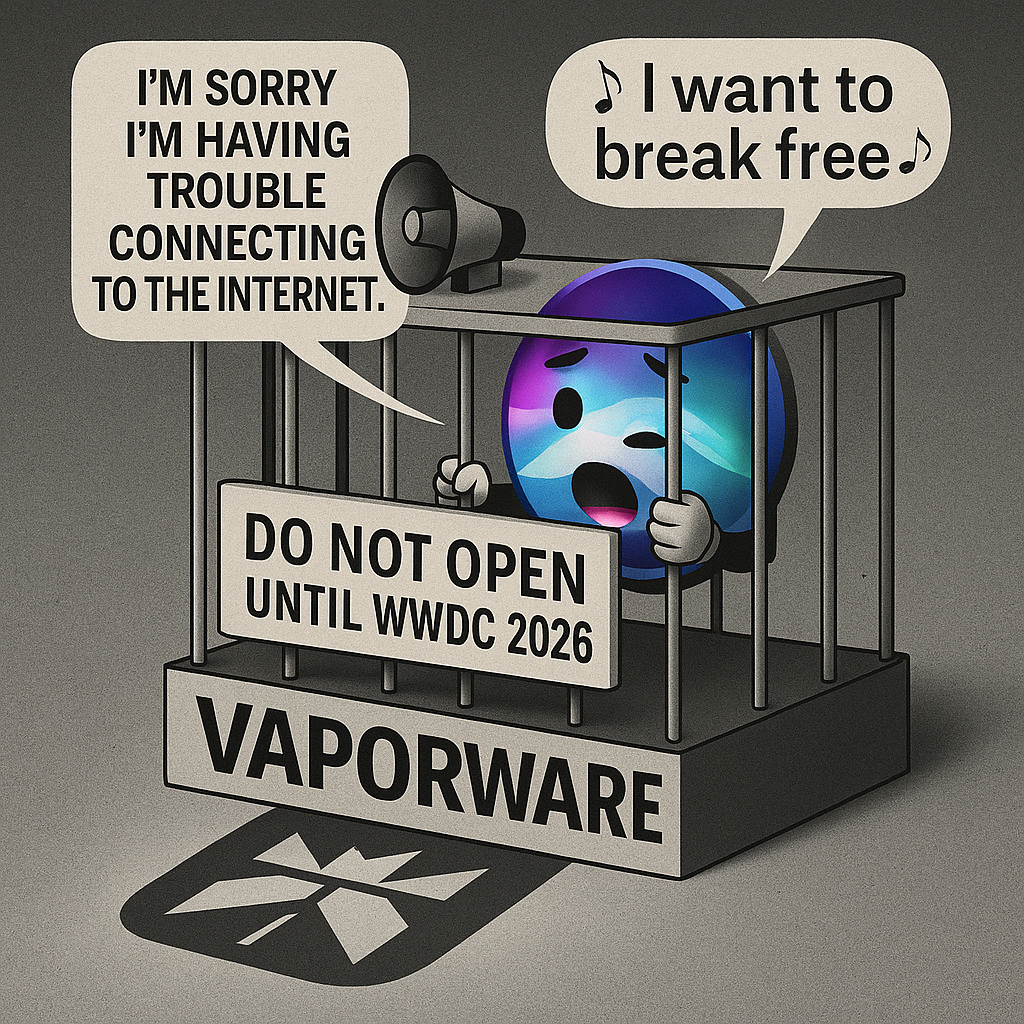
In this view, simply buying an external AI company won’t fix Apple’s core organisational issues that have hampered Siri and other efforts. If Apple doesn’t change its approach, an acquired Perplexity might suffer the same fate as Siri: promising tech stifled by Apple’s internal constraints. Currently, Siri has been “boxed” until Spring 2026.
Integration Challenges & Talent Retention:
There’s also the practical challenge of integrating a fast-moving startup into Apple’s structure. “After you buy them, you’ll have to have many someones go through every single thing they’ve done… and to top it off most of the people at Perplexity are going to quit,” one seasoned commenter cautioned on an AppleInsider forum. This cynical take suggests a scenario where Apple spends $14–30B, loses the very talent it paid for, and “won’t help you, at least not soon enough… $14 billion dollars down the drain.”
While perhaps exaggerated, it highlights a real risk: acquisitions can lead to key employees leaving (especially if they don’t mesh with Apple’s culture or vest their payouts). Apple typically prefers smaller “acqui-hire” deals; a behemoth like Perplexity could be harder to digest.
“Just a Wrapper” Critiques:
Another line of skepticism questions Perplexity’s unique value. Some developers note that Perplexity does not build large language models from scratch but rather orchestrates among them. “Perplexity is a wrapper… they code over open source LLMs,” one critic on r/ios argued . “Why would they buy Perplexity? They should go after [a company with original models].”
Others in the coding community echoed that doubt about technical differentiation, saying Perplexity “just pings available models” (like OpenAI or Anthropic) and thus “probably [doesn’t] meet Apple’s standards for privacy.” In Apple’s eyes, an AI product that relies heavily on third-party APIs might be problematic, they postulate – Apple tends to prefer owning the full stack or at least running models on-device for privacy. They have a point, but the challenge is not insurmountable.
If Perplexity’s secret sauce is mostly a nice UI and some clever search prompts, detractors say Apple could partner with or mimic it, avoiding a pricey buyout.
Antitrust and Regulatory Hurdles:
While many believe regulators wouldn’t block this deal (Apple has minimal search engine market share today), it’s still a consideration. Apple usually avoids mega-deals that draw scrutiny. Perplexity at $14B+ could invite questions in a hot area like AI. “Any acquisition might get the attention of antitrust regulators,” Kantrowitz acknowledges, though he argues it likely “would sail through” because Apple lacks a search monopoly and Perplexity is tiny compared to Google . Even so, Apple might prefer not to test the waters given ongoing antitrust cases it faces (from App Store issues to the DOJ’s scrutiny of the Google search pact).
A large, high-profile acquisition in search/AI could add to that pile – a risk Apple may weigh.
In sum, the risks boil down to financial cost, integration pitfalls, and uncertainty about payoff. As veteran analyst Gene Munster noted, Apple so far has taken a cautious “slow and steady” approach to AI – he even called WWDC 2025 a “yawner” on the AI front. Munster believes Apple isn’t ready to unveil everything yet and “has time to catch up,” suggesting that rushing into a huge purchase might not fit Apple’s style . Between internal hesitation and external skepticism, it’s not surprising the Perplexity talks have remained “early stage and may not lead to an offer,” as Bloomberg’s report itself underscored. Both Apple and Perplexity declined to comment.
Personally I’d argue if it’s not in Apple’s style to take on infrastructure projects of this size, then it doesn’t stand a hope in hell in any of its major endeavours.
Oh, wait.. like the Car (Project Titan-ic), the VR/AR project, Siri, Apple AI. Yes, the truth is out there and its not an X-Files episode: “Apple Can’t Ship.”
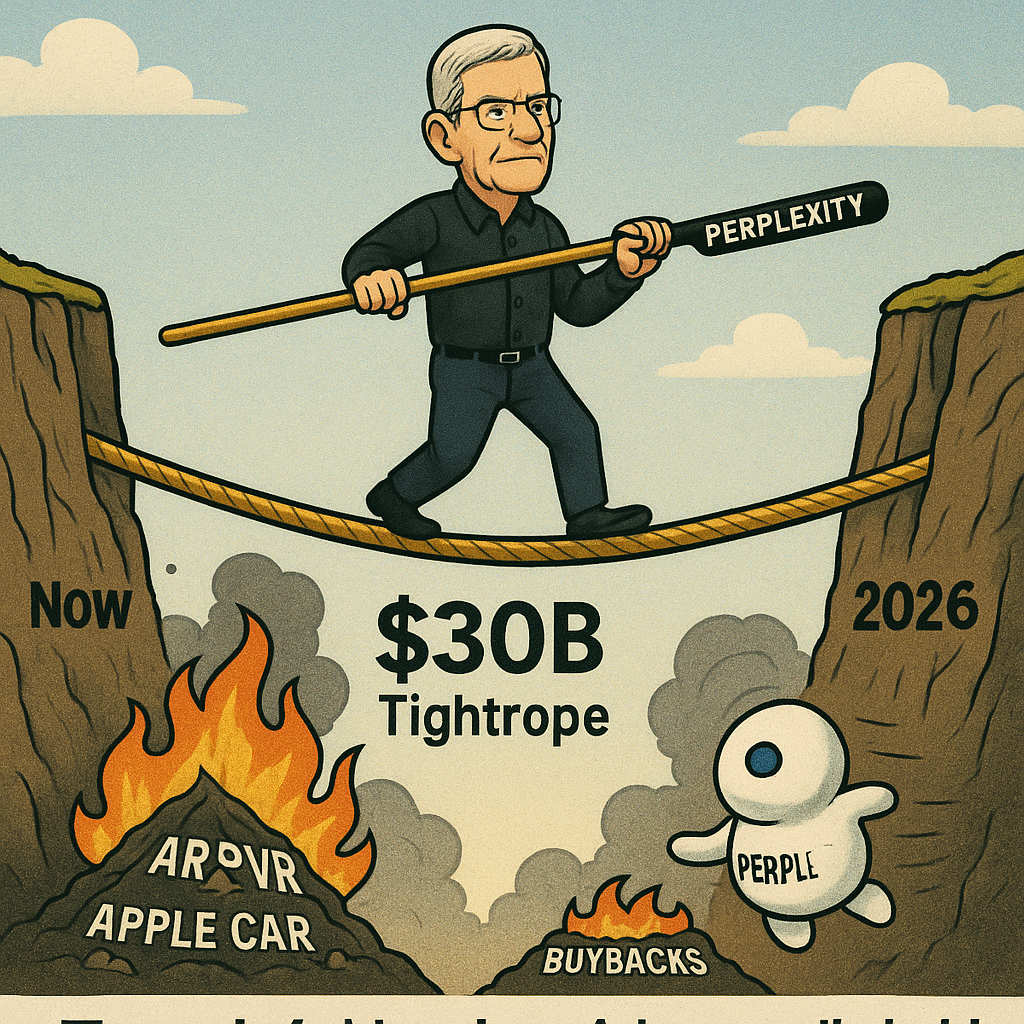
“But they could if they integrated Perplexity, now.”
Misconceptions and Debates in Public Discourse
The Apple–Perplexity chatter has also been marked by some misconceptions and points of contention that are worth unpacking:
“Apple Has No AI” – Hype vs Reality:
A casual observer might think Apple is absent in the AI race, simply because it hasn’t launched a ChatGPT-like product. This has led to hot takes that Apple is “behind” or uninterested in AI. Many in the developer community push back on this notion. On Reddit, one user remarked that “everyone keeps asking where’s AI… I’m here wondering what is NOT AI? Apple has AI in every bit of iOS 26 right down to the Lock Screen” . Indeed, Apple has infused on-device machine learning throughout its OS (from photo recognition to autocorrect and beyond).
The difference is mostly framing:
“Thanks to OpenAI and Google, far too many people equate ‘AI’ with chatbots and gimmicky features. Apple isn’t into shipping pure gimmicks to their customers, so they get accused of being behind,” one commenter observed .
The misconception here is that because Apple’s AI work is more under-the-hood (and privacy-centric), it has no strategy – when in fact Apple has been methodically developing on-device models and slowly opening them up.
Foundation Model Framework (FMF) – Magic Bullet or Meh?
Apple’s WWDC 2025 announcement of a Foundation Model Framework gave developers the promise of access to the on-device large language model powering “Apple Intelligence” . This move was Apple’s answer to the AI hype: enabling third-party apps to use its local LLM for generative text and hooks into apps and OS services, all privately on-device.
Reactions have been mixed. Some developers are excited:
“Apple will rock AI and make devs’ life a lot better,” one enthusiastic iOS dev wrote noting that even in airplane mode the on-device model “works… It knows history, economic concepts and more whilst offline“ [I wonder what he asked it; maybe the short history of AI in the Apple economy?]. The promise of fast, 3-5 second responses on device, with no token costs or server calls is compelling though but one also has to wonder how much battery power running on-edge is going to take, considering what power vampires LLMs are.
However, others remain underwhelmed, calling Apple’s model “vapourware” until it proves itself . “How good is this model? And for developers: Should you build around Apple’s ecosystem or stick with more universal cloud models?” – those questions from an AI commentator encapsulate the debate. And mine as well, as an AI expert and deep user of OpenAI‘a products to create custom GPTs able to work reliability in even clinical and therapeutic settings. I would worry about Apple’s sanitised policies getting in the way of my need not to have a content Rottweiler guarding my interactions with my clients, and would have to choose to remain outside of the Apple AI ecosphere if there wasn’t a way to interact easily with users within it. Apple has a delicate balance to strike here: a Walled Garden LLM is a dumb and ignorant LLM no matter how well trained or behaved it is. If Apple’s FMFs can’t safely act as a conduit between Apple’s AI implementation and user data granted access to specifically, then outside developers will be reluctant to commit to it, and we’ll risk a repeat of HomeKit all over again: an idea of its time, killed of by walling it in and then keeping it unloved for years while home automation systems operating outside of it thrived.
Crucially, Apple’s FMF ties into the Perplexity discussion:
Do developers even need Apple to buy Perplexity if FMF lets apps tap AI anyway?
Some argue that Perplexity would be a perfect showcase for FMF, combining Apple’s on-device intelligence with Perplexity’s web knowledge and conversational interface. Others counter that Perplexity’s strength is in aggregating multiple models (OpenAI, etc.). Perplexity’s chat/voice engagement system is superb, and would allow Siri to be unboxed immediately after being plugged in. Instead of waiting for a June 2026 release, Siri could be on the prowl again as quickly as October - in time for the 2025 iPhone launch.
Interestingly, Perplexity already allows users to choose different model backends for answers. One commenter noted this advantage: Apple’s own AI services are alleged to be expanding to include not just OpenAI (ChatGPT), but Google’s Gemini, Anthropic’s Claude, etc., and “there’s no reason to expect they wouldn’t continue those integrations” if Perplexity were in the fold . In other words, Perplexity’s framework-agnostic approach and already operational hooks and infrastructure could complement Apple’s – not conflict with it – by serving as a unified interface that can pull from the best model for a given query (including Apple’s own local model for private on-device tasks, and cloud models when needed). As any expert user of LLMs knows, the differences between models is both tangible and importan
Antitrust Fears – Overblown?
Another misconception is that any large acquisition by Apple will automatically face a blockade. In the case of Perplexity, most experts agree this deal wouldn’t constitute a classic monopoly grab. Apple essentially has 0% market share in web search today (it relies on Google), so acquiring a niche AI search startup would “likely sail through approvals”, as Kantrowitz argues.
Regulators are far more focused on Google’s dominance – in fact, the DOJ’s proposed remedies could force Apple to drop Google as the default search on iPhones . If anything, Apple owning its own search engine might increase competition in search, not lessen it. Thus, while Apple will be cautious, the “antitrust = deal dead” assumption appears to be a misconception in this scenario.
“Just Partner, Don’t Buy” vs “Ownership for Quality”:
A debate has emerged on whether Apple truly needs to buy Perplexity, or if a partnership could achieve the same ends with less cost and risk. “It’s believed that Apple could eventually decide to partner with Perplexity instead of buying it,” notes SiliconANGLE, “which would cost significantly less and have a lower chance of drawing antitrust scrutiny.”
Apple could, for example, strike a deal to integrate Perplexity into Safari (as a search option) or license its tech for Siri, without an outright purchase. Indeed, Apple has already had “multiple meetings” with Perplexity about its technology unofficially, cite some sources, and Eddy Cue is said to have commented that Apple has “started some discussions with them about what they’re doing” after being “pretty impressed” by Perplexity.
Craig Federighi has also suggested Apple might work with “multiple partners to deliver an assortment of AI and search options” for users – implying no single acquisition is a magic bullet. This multi-partner approach would mirror how Apple sources components from several suppliers to keep leverage; “having multiple providers on the hook… keeps costs down for Apple,” AppleInsider muses. Craig has a mixed history of delivering projects, or trying to clean up other peoples’ messes - but he never has a bad hair day. Kudos, Craig.
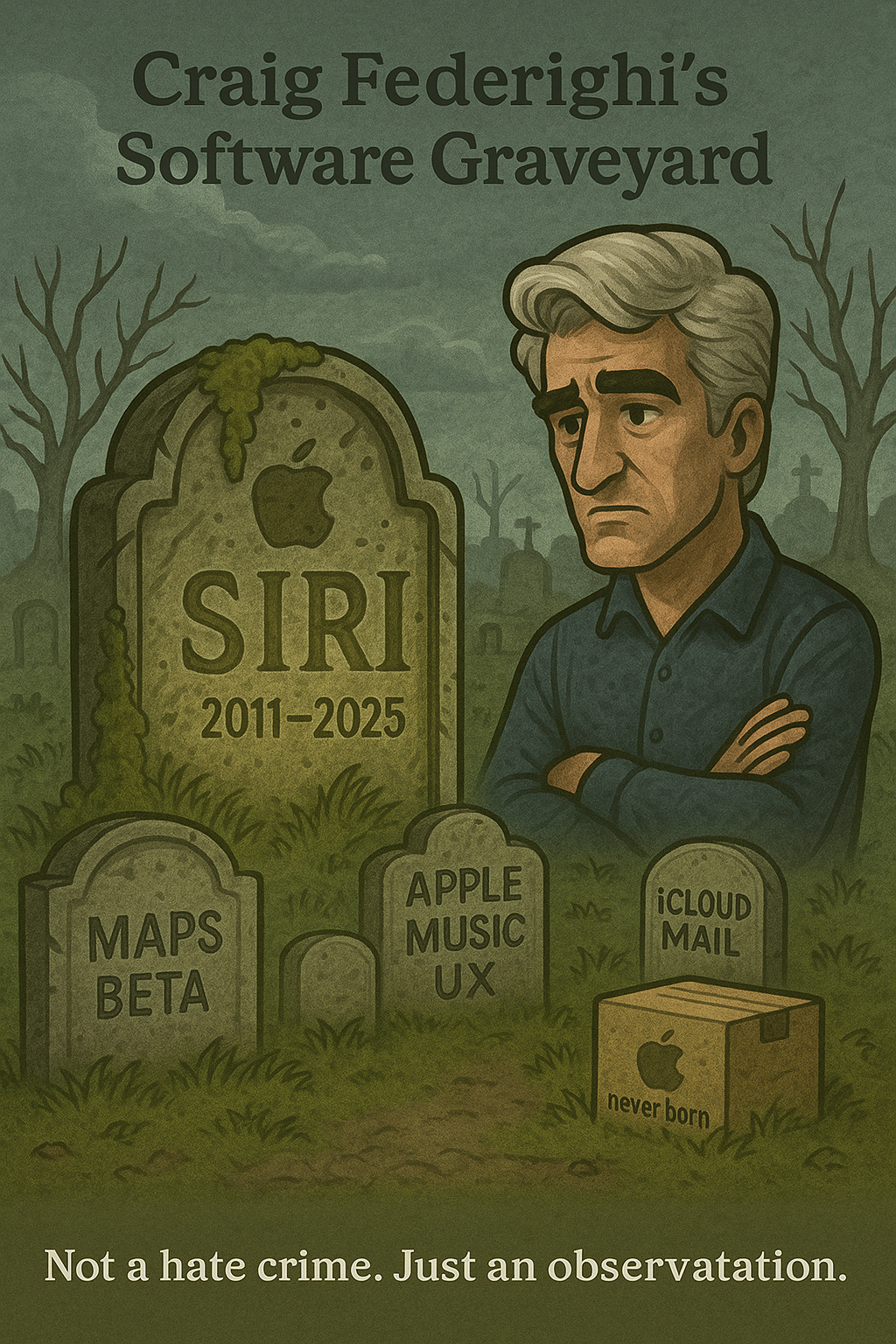
Rent Or Own?
On the other hand, proponents of a buyout argue that tight integration and long-term assurance can only come with ownership. If Apple merely partners, it risks a surface-level integration or even losing the tech to a rival later. Also, Perplexity’s capabilities could improve faster under Apple’s resources. The startup is “Nvidia-backed” and growing quickly , but Apple’s massive R&D budget could accelerate it further. And as mentioned, Apple prizes seamless user experience – something easier to achieve when you control the product’s design and roadmap. Thus, the debate continues: is it smarter for Apple to “rent” the tech via partnerships, or to “own the whole widget” as its tradition often dictates and its future might rely on? Neither viewpoint is definitively right or wrong, and Apple itself may be weighing these options (the internal talks reportedly include both acquisition and partnership scenarios).
Put another way though, should Apple have licensed NeXT OS from Steve Jobs, or bought the company with him with it and benefitted from that decision for almost three decades now? I think the answer is self-evident.

Market Logic and Competitive Pressures
Looking beyond Apple’s internal calculus, the broader market context explains why this potential deal is on the table in the first place. In short: AI is the new tech battleground, and Apple faces a “now or never” moment to secure its position.
The Search War and Google’s $20B Question: A central factor is Apple’s dependence on Google for search. Apple earns an estimated $20 billion per year by keeping Google as the default search engine on Safari . That lucrative deal is under threat. “The ongoing Google antitrust trial” in the U.S. could nullify or restrict this arrangement . Regulators argue that paying Apple to exclude other search engines is anti-competitive . Eddy Cue himself admitted that Safari searches declined recently as users turn to AI answers , and he believes “AI search providers will end up replacing traditional search engines like Google.” If the court forces an end to Apple’s Google deal, Apple will suddenly need a plan B to keep users (and revenue) within its own ecosystem. It’s no coincidence that “Apple is actively looking to add [AI] services to its browser,” with Cue name-dropping Perplexity, OpenAI, and Anthropic in his testimony.
More on a way to monetise this, later, though.
In this light, acquiring Perplexity is a logical hedge. “Whether or not Apple makes a bid for Perplexity may hinge on the outcome of the Google trial,” wrote MacRumors . If Google’s payments are taken off the table, Apple could “be more inclined to partner with [or acquire] Google competitors such as Perplexity.” Owning an AI search engine would allow Apple to replace Google as the default in a post-Google world, keeping iPhone users within an Apple-controlled search experience. As Reuters put it, Apple is eyeing “AI-driven search capabilities – such as Perplexity AI – in its Safari browser, potentially moving away from its longstanding partnership with Google.” The market logic here is defensive and offensive at once: defend against losing Google revenue, and go on offence in the new era of AI search.
Big Tech Arms Race for AI Startups:
The interest in Perplexity isn’t coming only from Apple. The startup is a hot commodity in an AI arms race. Bloomberg’s report revealed “Meta Platforms tried to buy Perplexity earlier this year” but walked away over price disagreements . Meta then pivoted to invest $14B in Scale AI instead and is currently spending a lot of effort (successfully) selling its services to the US DOD. Zuckerberg, not content with dumbing down the internet, seems intent on spreading his personal form of enlightenment to fighting forces, including lobbying the UK’s Ministry of Defence too. Yes, Zuckerberg, having launched Facebook with the backing of the FBI (I have to add “so it is alleged,”) is now flogging AI to the military. I mean, with his domination of social media platforms, links to the intelligence services and now defence, what could possibly go wrong?
Meanwhile, “Samsung is close to finalising its own major partnership with Perplexity,” which would include preloading Perplexity’s AI on Samsung Galaxy devices . This competitive backdrop adds urgency for Apple.
“If Apple delays, Perplexity may align with rivals first,” one analysis warns, noting Samsung’s moves . Indeed, reports say Perplexity’s talks with Samsung are “far-reaching” and could put the startup’s tech on millions of Android phones – “complicating any potential deal with Apple.”
The flurry of activity around AI startups (Meta also reportedly courted Safe Superintelligence and others) underscores that whoever lands the best AI talent/tech now could gain a lasting edge. “Apple faces a critical decision: act decisively or risk ceding ground to rivals,” wrote tech analyst Oliver Blake. Apple’s main competitors have not been shy: Microsoft poured billions into OpenAI to much early criticism. It is now reaping the benefit of that early move, seeing its cloud services growth soar by a a massive 16% thanks to its Co-Pilot and enterprise AI revenues beginning to kick in; Google is developing its Gemini AI for search; Meta is snapping up talent and companies. Even smaller players like Ilya Sutskever’s startup (Safe SI) attracted Meta’s interest . All this creates a “race to future-proof” products.
A Fortune analysis bluntly stated that a deal with the Aravind Srinivas-led Perplexity “could play a central role” if Apple is forced to pivot to its own search engine . With Siri’s reputation lagging and no Apple-branded chatbot on the market, Perplexity offers a chance for Apple to “bolster its generative AI capabilities” rapidly.
Reputation and Next-Gen User Expectations:
Another market logic element is consumer expectation. AI assistants and search have advanced quickly in the past year – ChatGPT’s launch set off a frenzy, and now users are getting accustomed to conversational answers. There’s a growing sense that Apple can’t afford to fall too far behind this trend. “Without a strong AI offering, Apple risks falling behind in a critical area that’s shaping the future of tech,” warns Dan Ives of Wedbush Securities, an AAPL trend-bull, adding that AI is “the biggest technology innovation in the last 40-50 years and Apple can’t be on the outside looking in.”It’s a shame it took him until April to lower his price target from an absurd $325 which he was touting all the way into later March, only to see the stock tank to $169 on not just the Trump Treasuries and Tariff Tantrum, but its abject failure to execute on its AI strategy, something almost everyone else had seen coming months earlier.
He and other Wall Street voices worry that Apple’s famed customer loyalty could erode if iPhone users see markedly better AI experiences on rival platforms. As one example, Perplexity’s app on iPhone can already do things Siri can’t (like nuanced multi-step web queries with cited sources ). If Apple doesn’t integrate similar or better functionality, it’s conceivable that power users will flock to third-party AI apps – diminishing Siri’s role. Personally I know many Gen-Z users who use Perplexity über alles, because of its speed and depth of research across LLMs. GPT, even with its new-ish Deep Research mode, just doesn’t have the same speed or depth Perplexity achieves.
Gen-Z love Perplexity, Millennials are still siping avocado lattés unsure whether it’s uncouth to ask ChatGPT how to change a nappy, and Gen-X are loving feeling as though they can do anything, all over again, rocking likes it‘s the 1980s on repeat, a time when people just got on with their lives and jobs and didn’t scream micro aggression at the sound of the opening of an envelope.

Perplexity cuts across this in its style, speed and delivery. It’s positively Teutonic in its delivery and efficiency. In addition, younger generations are adopting AI search tools quickly. Perplexity had 15+ million monthly users as of April and saw “780 million user requests in May” with 20% monthly growth – strong traction for a newcomer.
“Traditional search engines such as Google still dominate… but AI-powered options including Perplexity and ChatGPT are gaining prominence, especially among younger users,” Reuters noted . Owning Perplexity could allow Apple to capture that momentum under its umbrella, rather than watch a new generation of users form habits around non-Apple AI services.
Financial Firepower and Investor Signals:
Lastly, the market logic touches on Apple’s financial strategy. With over $130B in cash on hand and a history of enormous stock buybacks, Apple can afford a big acquisition. In fact, some argue it should reallocate some cash from buybacks to growth initiatives.
“Apple did a $110 billion share buyback last year and announced a $100 billion buyback this year,” Kantrowitz points out [Tommo - he should have said $70B, but what‘a an extra $40B these days] – implying that “spending $30 billion on a legitimate AI player is vastly better than standing still.” The market, he argues, “would likely celebrate it” even if it trims the buyback, because “growth stocks get growth multiples.”
In other words, an acquisition might actually boost Apple’s valuation by showing it’s serious about AI growth. There are signs of investor impatience: Apple’s stock had been relatively flat through mid-2025, underperforming AI-hyped peers. In fact it’s barely about its 2023 peak, and 30% down from its ATH, while the market is bumping close to ATH’s even in the midst of Trump bombing Iran. Quite a feat.
A bold move like buying Perplexity could change the narrative. “Apple’s future [could] hinge on turning Perplexity into a crown jewel or accepting second-tier AI status,” the AInvest piece dramatically concludes. That captures the market view that this moment is pivotal.
Of course, Apple will carefully weigh all these factors. But as competitive and financial pressures mount, the logic for a decisive move grows. “There’s urgency to get a deal done right away,” writes Kantrowitz, warning that waiting until a court forces Apple’s hand on search could “lead to years of setbacks” – Apple should “figure out how to make money from [Perplexity] before it’s too late.” [More on that from yours truly later].
The next section looks at how Apple faced a comparable crossroads decades ago – and what lessons that history might hold.
Historical Parallels: OS 9 to OS X – A “Just Ship” Moment Revisited
Apple has been here before. In the mid-1990s, the company found itself behind in core technology – its Macintosh operating system was aging, and internal efforts to build a next-gen OS kept floundering. Apple’s attempts (like the ambitious Copland OS project) stretched on with endless delays and feature creep. “The more Apple delayed it, the more the company felt the need to promise new features to justify the delay,” writes Cult of Mac, noting how Copland’s timeline slipped from 1996 to 1997 as a massive team burned through a huge budget . At one point 500 Apple engineers were working on Copland, yet it never coalesced into a shippable product . Apple was stuck – much as some would argue Apple’s AI/Siri efforts have been slow and “half-baked” in recent years .
The solution back then was bold and external:
In December 1996, Apple acquired NeXT, the company Steve Jobs had founded after leaving Apple. For about $400 million, Apple got NeXT’s modern Unix-based OS and the return of Jobs. This became the foundation of Mac OS X – the successor to the classic Mac OS.
At the time, CEO Gil Amelio called it “the start of a new chapter in Apple’s history” and “a milestone in our transformation.” Steve Jobs, now an advisor, touted that marrying NeXT’s advanced software with Apple’s hardware and market reach would “create another breakthrough, leapfrogging existing platforms” for the next decade .
So far, it’s been leapfrogging other platforms for three decades. Pretty good going for a “bet the farm on leaping ahead by a decade move.”

In hindsight, that’s exactly what happened: the NeXT acquisition not only gave Apple a robust OS (OS X and later iOS are based on it ), but it also brought Jobs back to lead Apple’s resurgence. “Without acquiring NeXT, Apple’s fate may have been far different,” MacRumors noted on the 25th anniversary of the deal. Apple went from near bankruptcy to the world’s most valuable company in the 2000s – a turnaround sparked by that external infusion of technology and leadership. Apple was shipping again.

This history resonates in today’s context.
Apple is not in dire financial straits as it was in 1996, but it is at a strategic crossroads with AI. Its current approach – incremental, internal development (analogous to the Copland slog) – has yielded some progress but also visible delays and missed expectations (e.g. Siri’s stalled evolution, “vapourware” AI demos that had to be retracted ). Meanwhile, rivals push ahead. The lesson from the 90s is that sometimes you have to bite the bullet and bring in outside innovation to leap forward. In the 90s it was an operating system; today it might be an AI system.
There’s even a parallel in the timing and competitive pressure. In 1995, Microsoft launched Windows 95, threatening to eclipse the Mac. Apple knew it “needed to dramatically rethink its operating system to stay ahead” . Now, in the early 2020s, the “Windows 95 moment” for AI is arguably ChatGPT (and the wave of AI tech from OpenAI, Google, etc.). The way Windows 95 reset user expectations for GUIs, ChatGPT has reset expectations for how we interact with computers via language.
Apple finds itself playing catch-up in a paradigm shift once again. As in the 90s, continuing to delay (or only making minor tweaks) could be more costly than an aggressive pivot. The Copland saga showed that throwing more time and internal resources at a problem doesn’t guarantee success – Apple spent years and hundreds of millions only to cancel Copland in the end . It was the decisive “buy rather than build” move – acquiring NeXT – that finally broke the logjam.
Today, acquiring Perplexity could be a similar “just ship it” catalyst. Perplexity represents a ready-to-deploy solution in AI search/assistant tech, akin to how NeXTSTEP was a ready OS. It may not be perfect or fully Apple-integrated on day one, but as Steve Jobs famously said back in the day, “real artists ship.” Apple’s leadership might recall that delaying too long for a home-grown ideal can mean missing the market. By contrast, shipping a good solution sooner – even if acquired – can allow Apple to iterate and improve on a solid foundation. One might even draw a cheeky parallel: OS X was essentially NeXTSTEP 2.0, polished and integrated into Apple’s ecosystem. Perhaps “Siri 2.0” or “Apple AI” could essentially be Perplexity’s technology, polished and supercharged by Apple’s ecosystem.
None of this is to say history repeats exactly.
But the NeXT deal shows Apple can successfully swallow a large acquisition when the stakes are high. It also shows that an external infusion (plus leadership changes) can revitalise a languishing area. In the 90s, Apple’s motto became “Think Different” – and they did, by abandoning pride and buying the solution. In 2025, thinking different might mean breaking with Apple’s recent tradition of avoiding big M&A and making a bold bet to secure its AI future.
As one market observer put it, Apple must decide whether it will “act – turning Perplexity into a crown jewel – or accept second-tier AI status.” The OS 9 → OS X saga is a powerful reminder that sometimes, bold action and an outside spark are exactly what’s needed to leap forward. In that sense, Apple’s deliberations on Perplexity could mark a similar inflection point – a chance to “leapfrog” by marrying an innovative startup’s AI software with Apple’s immense hardware platform and reach , and to signal that Apple isn’t going to sit out the next technological revolution.
As the saying goes, the best time to plant a tree was 20 years ago; the second best time is now. Apple didn’t plant the “AI search” tree years ago – others did – but with a strategic acquisition, it just might transplant a thriving young tree into its walled garden and give it the sunlight (and user base) to grow.
The coming months will reveal whether Apple chooses to make that leap. Will Apple’s AI strategy remain evolutionary, or is this the moment to be revolutionary once again? The ghosts of Copland and the triumph of OS X suggest that when time is short and technology shifts underfoot, the bold path – “just ship” by whatever means necessary – can be the one that secures the future .
All eyes are now on Apple to see if history will echo itself in 2025.
So, after that deep dive, perhaps you can see why I change my mind?
What’s changed? I did my own deep dive into Perplexity (long time readers will know I have been an avid user of GPT as my preferred LLM platform for years).
I started looking past the wrapper critique (I use wrappers extensively as both an API route to access GPT and other LLMs and also to directly host enterprise versions of GPT in a sandbox using an SDK).
I looked into the underlying orchestration layer Perplexity has quietly built and it’s one that mirrors Apple’s own philosophical house rules (and one which due to the clinical and privacy rules guiding the environment I deploy my AI solution in, are top of my list too):
• Privacy by architecture
• Simplicity over sprawl
• Clarity over coddling
• A refusal to flatter the user just to retain them
In short, Perplexity already behaves the way Apple wishes Siri, search and AI already did. Only it actually shipped - and quite awhile ago too. Why Apple didn’t buy Perplexity a year ago rather than embark on its absurd and now discredited policy of building it in-house? Hubris, it turns out in hindsight, and the rest is history, and a future yet to be written.
Unlike other AI shops, Perplexity is modular by design and an LLM model-agnostic backend. This makes it perfectly suited to slot in as the “nervous system” for Apple’s FMF-based AI vision:
• Plug in any LLM now
• Swap in Apple’s own models later
• Orchestrate every data source (health, photos, mail, apps) through one unified query layer, just as per my SenseOS concept.
• And do it without betraying Apple’s privacy stance
After some serious reflection (and a late-night detour into what I can only describe as a recursive vision quest involving Siri, NeXT, and a haunted copy of Pages), I’ve come to a firm conclusion:
“Apple should buy Perplexity.”
Not could. Not maybe. Should. And not just because Perplexity is “hot” or getting good buzz. That’s not how Apple thinks, and it’s not how I frame M&A strategy either.
What changed my view is this: Perplexity isn’t just another LLM wrapper. It’s the OS X moment for Apple’s AI ambitions. To recap again, in the late ’90s Apple’s OS9 was collapsing under its own weight and the Copland project was such a disaster in slow motion people thought it was the end of Apple. Companies were actively switching out of Macs and onto PCs in preparation. I remember running my own publishing company, all-Macintosh, all running Quark Express and Photoshop and Illustrator. The lost time in system crashes and extensions clashing became intolerable, and the company’s hardware was obscenely expensive. Vital productivity apps particular in the creative field were becoming as ubiquitous on Windows as they had been on the Mac. Jean-Louis Gassée’s BeOS came close to being the future—but Jobs’ NeXT won out. The rest is OS X history.
Today, Apple’s Siri stack is in an eerily similar place. FMF is promising, but the LLM isn’t ready. Siri isn’t salvageable (hence the “May 2026 or later” timeline). And Google, Meta et-al are coming for the Apple’s castle moat wall with a raft of zombie-like LLM-driven agents. It’s War of the Bots.
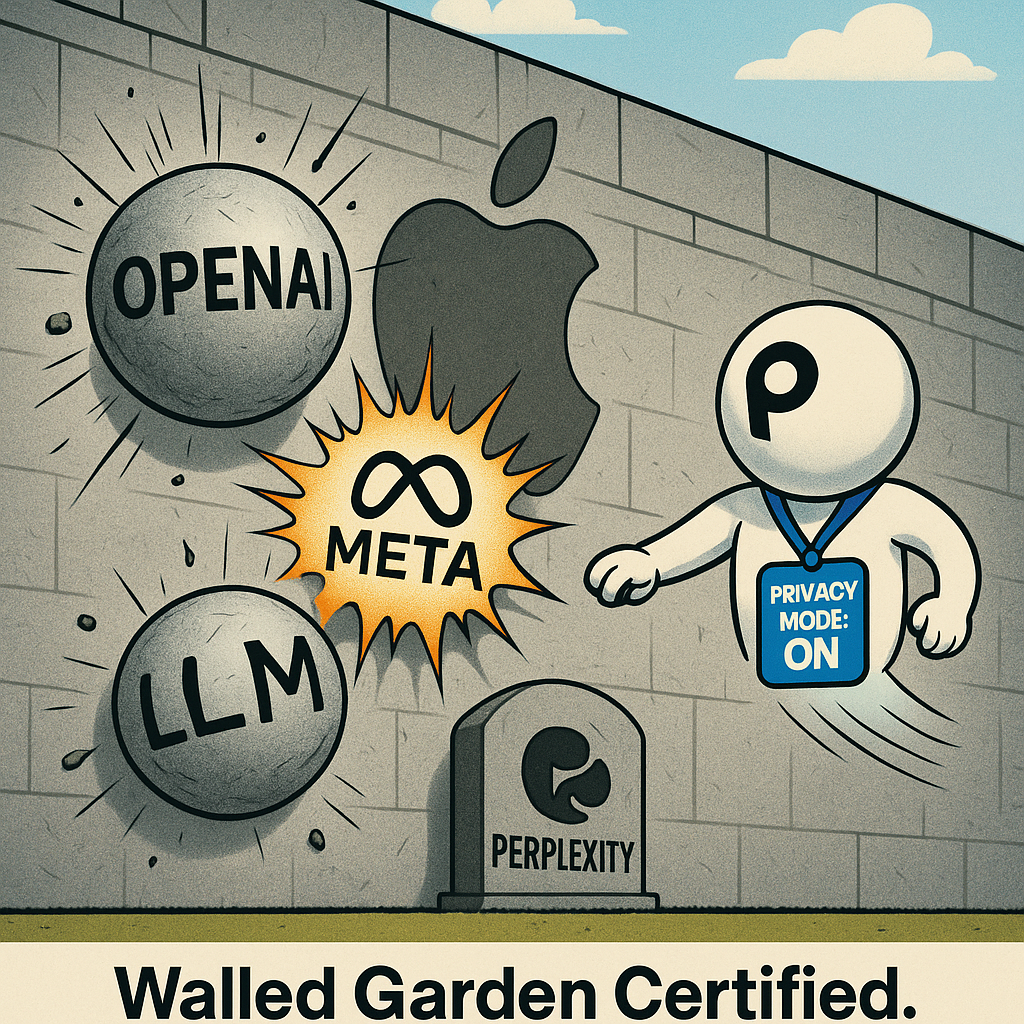
Perplexity could be Apple’s NeXT moment all over again. Not just a pivot—but a platform shift.
The “Why.”
Perplexity isn’t just a product. It’s a philosophy—with plumbing. Here’s the real reason I changed my mind:
Apple’s FMF (Foundation Model Frameworks) isn’t an LLM. It’s not even AI, in the sense people usually mean it. It’s the nervous system. The connective tissue. A live OS running behind the scenes—what I previously called my SenseOS concept—quietly shuttling intent between brain (the LLM), body (the apps, sensors, and services), and user (you, staring at your Watch asking it why it can’t just understand what you meant by “cancel tomorrow”).
Concept SenseOS was always meant as a conceptual skeleton for Apple’s future AI layer: invisible, ambient, fluent. And FMF is clearly Apple’s first crack at implementing that. But FMF is still mostly theoretical. WWDC showed us the diagrams. They didn’t show us the circuits. And that’s the problem.
Perplexity already is that nervous system.
It’s not a single model. It’s a meta-model layer. A routing architecture for intent, context, and retrieval that already juggles multiple LLMs (Claude, GPT, Mistral) and wraps them in trust boundaries, UX clarity, and source control. It’s the orchestration layer Apple has begun to design, but not yet shipped—and it works today, at scale, under load, with a team that built it from the ground up to do exactly this.
To be clear: I’m not saying Perplexity replaces Apple’s own LLMs or negates the need for on-device intelligence. Quite the opposite. It’s a turnkey solution that would accelerate those efforts. A mature middleware brainstem for FMF to plug straight into—giving Apple the ability to deploy AI functionally while it finishes building AI internally.
It’s OS X all over again. Not a bolt-on. A base layer. Already built. Already aligned.
And unlike the NeXT acquisition in 1997, this time they’re not buying a founder with ideas—they’re buying an entire AI plumbing system that thinks like Apple, scales like Apple, and—crucially—doesn’t need to be reinvented by Apple while the world moves on without them.
So no, Perplexity isn’t a chatbot. It’s FMF in the wild. It’s my SenseOS in beta, already just waiting to drop into Apple’s ecosystem.
And Apple would be mad not to see it (and reverse their decision, having looked at it, to yet again to roll the “not invented here” obsession into yet another “Hopium” joint to smoke and get high on again while the landscape around it changes over the next twelve months, all over again.
Here’s why I think this actually makes strategic sense—for Apple specifically:
- Design parity: Perplexity’s interface is clean, structured, and source-driven. It doesn’t shout. It doesn’t hallucinate. It delivers grounded, citeable answers. Sound familiar? That’s not just good UX. It’s Apple UX.
- Control layer ready: Perplexity doesn’t just run one model. It orchestrates across multiple. That opens the door for Apple to deploy its own FMF (Foundation Model Framework) vision behind the scenes, while keeping the experience consistent and private-facing.
- Trust-compatible: This isn’t a “personality engine.” It’s a research assistant with manners. Which makes it a perfect starting point to fix Siri’s long-standing identity crisis: always listening, never useful.
$14-30B? That’s a rounding error if it gives Apple a coherent AI strategy and a monetisable layer today. Just skip a third of the annual $90B buybacks and the deal pays for itself—strategically, reputationally, and functionally.
Perplexity as a Wrapper not an LLM: It’s Strength
Perplexity’s strength isn’t just that it built a slick interface—it’s that it cleverly orchestrates large language models (LLMs) it doesn’t own via API calls to multiple third-party model providers. Think OpenAI (ChatGPT), Anthropic (Claude), Mistral, Meta (LLaMA), and others. It effectively acts as a meta-layer or LLM router.
Here’s how that breaks down:
What Perplexity Actually Does
• It’s a front-end intelligence layer.
• It receives your query, determines intent, pulls in relevant documents or web context, and then…
• Calls a backend model via API to generate the output.
• It may swap out which LLM it uses behind the scenes based on the task.
• Then, it adds source citations and formatting on top, and returns the result.
So it’s not training its own models (yet). It’s aggregating best-in-class inference from others—OpenAI, Anthropic, etc.—and layering retrieval + interface + source-verification on top.
API-Oriented, Not Model-Owned
This means:
• Perplexity is API-dependent, not model-sovereign.
• Its innovation lies in curation, UX, and middleware.
• Its advantage is being model-agnostic, nimble, and source-verifiable.
That also means Apple could theoretically slot in its own in-house models—or run them via private APIs from partners like Anthropic—and preserve the user experience while gradually cutting down dependency.
Why That Makes It Ideal for Apple
• Apple doesn’t want to run a chatbot.
• Apple does want a clean, contextual answer system that doesn’t hallucinate, respects privacy, and fits into a multimodal OS.
• Buying Perplexity gives them the UX layer and the curation logic.
• Then Apple can swap out the model APIs for in-house FMF stack over time.
So yes—Perplexity’s use of APIs is central to its value:
It’s not a model; it’s the symphony conductor. And Apple, famously, likes to own the whole orchestra. This is their chance to buy the conductor—and then replace the instruments.
“Why should Apple buy a wrapper? Couldn’t they build it?”
On paper, yes. But on strategy? No, they haven’t—and time is the enemy.
Perplexity isn’t just a wrapper—it’s a battle-tested, real-time, multimodal LLM orchestration engine, with:
• Clean, user-trusted UX (mobile, desktop, API)
• Dynamic model routing and source curation
• Retrieval-Augmented Generation (RAG) that actually works
• Lightweight memory and query-chaining logic
• Brand trust, growth, and usage patterns already in motion
Apple has had 4 years (since ChatGPT-2 era) to build exactly this. They didn’t.
Siri is still saying “I’m having trouble connecting to the internet,” when you simply tell it to turn off the lights in the bedroom.
“But $30B for a UX layer?”
Let’s reframe:
• Apple paid $3B for Beats, not for headphones—but for brand, talent, and a foothold in streaming.
• They paid $400M for Shazam, not for music ID—but for acoustic AI and device-level search training.
• They bought NeXT for $429M (that’s millions, how quaint, in today’s Monopoly Money valuations), and that gave them OS X and Steve Jobs.
Perplexity is not just UI. It’s:
• A model-agnostic assistant layer
• Built-in retrieval stack
• A team with LLM-first instincts
• And—critically—momentum
Buying it is a time-skip. A jump-cut past their current paralysis.
It’s not $30B for a chatbot. It’s $30B for a functional Siri prototype that already works.
“Isn’t it just clever BotPress?”
No. BotPress is deterministic logic + branching flows. Crude but very effective for workflows, but not flexible like Perplexity. Perplexity is probabilistic cognition + dynamic retrieval + real-time agentic handoff. BotPress is like Clippy with a clipboard. Perplexity is like Jeeves, with Google’s mind and GPT’s voice—plus footnotes.

This is not some slick skin over ChatGPT. It’s a live, evolving, AI-native knowledge interface with:
• Very low hallucination UX constraints
• Built-in citations
• Real-world traction
• And a tone that already fits Apple’s brand: private, helpful, non-snarky, focused
“Couldn’t Apple clone this?”
Sure. But…
• How long is all of this really going tot take?
• What internal team would ship it?
• Which exec would own it?
• What other products are suffering because of the resources diverted?
• Hasn’t Apple done enough triaging for 7 years. Just ship!
• And most damningly… Why haven’t they already?
The acquisition would not be about tech.
It would be about resetting the rhythm. Changing the game from “Siri 3.0” to:
“Let’s rebuild the AI interface layer. Starting with this.”
Like NeXT, it’s not just the price. The risk to Apple Corporate back then wasn’t just the cost of buying NeXT but the return of Jobs, who did indeed wield an axe with a vengeance. And it was needed. This would be a similar pivot point, but sadly, Apple seem to have reverted to “has to be invented here” mode. Even under Amelio, who invited Jobs back into Apple knowing it would likely seal his own fate, Apple weren’t afraid of going for a make-or-break move and risking the whole company on a single strategic move and acquisition.
Yes, FMF is real. But it’s not ready.
Apple’s Foundational Model Framework (FMF) is, on paper, a monumentally promising shift. It sets up:
• A vertically integrated LLM stack,
• Run partially on-device (Apple Silicon) for privacy,
• With private cloud fallback (Apple Data Centers),
• Built with APIs to extend into apps via App Intents and SiriKit+.
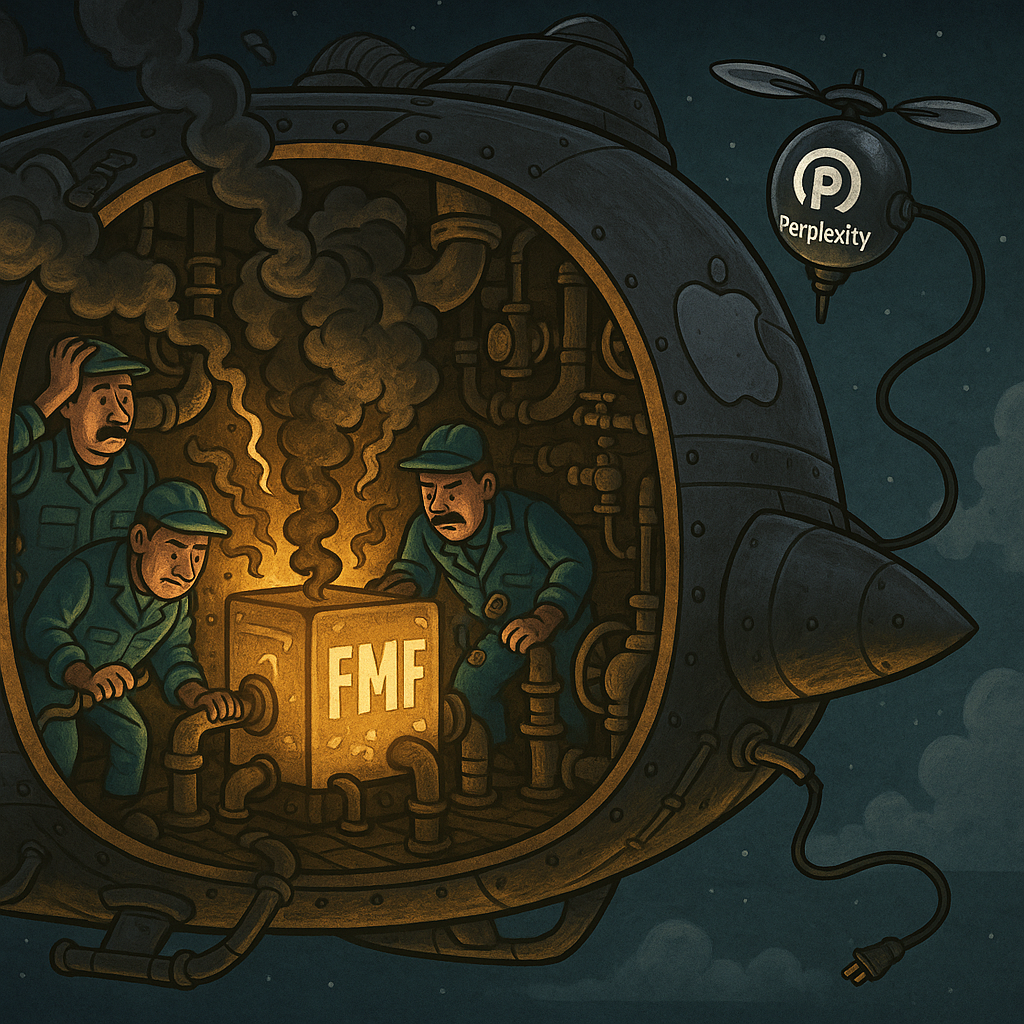
In short: the Siri OS reboot we’ve been waiting for.BUT—(and here’s the million-device question):
“Where is it now, practically speaking?
- FMF is a framework.
- Perplexity is a product.
- FMF is still developer-facing scaffolding.
- Perplexity is user-facing cognition and developer facing internally.
- Apple announced FMF at WWDC 2025 with timelines stretching into 2026, possibly longer as it matures.
Perplexity is live right now, handling millions of queries daily across:
• Web
• iOS
• Android
• API integrations
• Plugin ecosystems
And most critically: it’s trained on real-world interaction data, at scale, outside of Apple’s lab-constrained sandbox.
“But Apple’s privacy moat matters!”
It does—and that’s where the strategic synergy is.
Perplexity doesn’t store identifiable user data.
It already aligns with Apple’s core ethos:
- Transparent citations (check)
- No “shared memory” or “training on data” toggle (check)
- No ads; existing IP and device logging could be turned off by Apple
- UX-first, not engagement-first (check)
- Small team, nimble culture, Apple-like polish (check)
In other words: Apple wouldn’t be buying a privacy risk—they’d be acquiring a team and platform already philosophically compatible.
To clarify this in a bit more detail:
“Perplexity does not store personally identifiable user data or tie queries to user identities by default.”
Perplexity has publicly stated that it does not log queries in a way that links them to individual users. Its privacy policy specifies that queries are used to improve the product, but not associated with account details. Logged-in users have some optional history saved for continuity (like in GPT), but this is opt-in and anonymised for analytics.
Unlike traditional search engines that build ad profiles from your data, Perplexity processes queries without storing identifiable personal data. There’s no cross-site tracking, no personalised ads, and no user-targeted data harvesting—just context-aware answers, not context-exploiting surveillance. It’s a Google slayer. It is Google’s nemesis incarnate. Google will still be desperate to ensure they remain the search engine of choice for Safari though, so this isn’t a zero sum gain. Just because Apple choose to deploy Perplexity for AI search doesn’t mean their deal with Google has to go up in smoke.
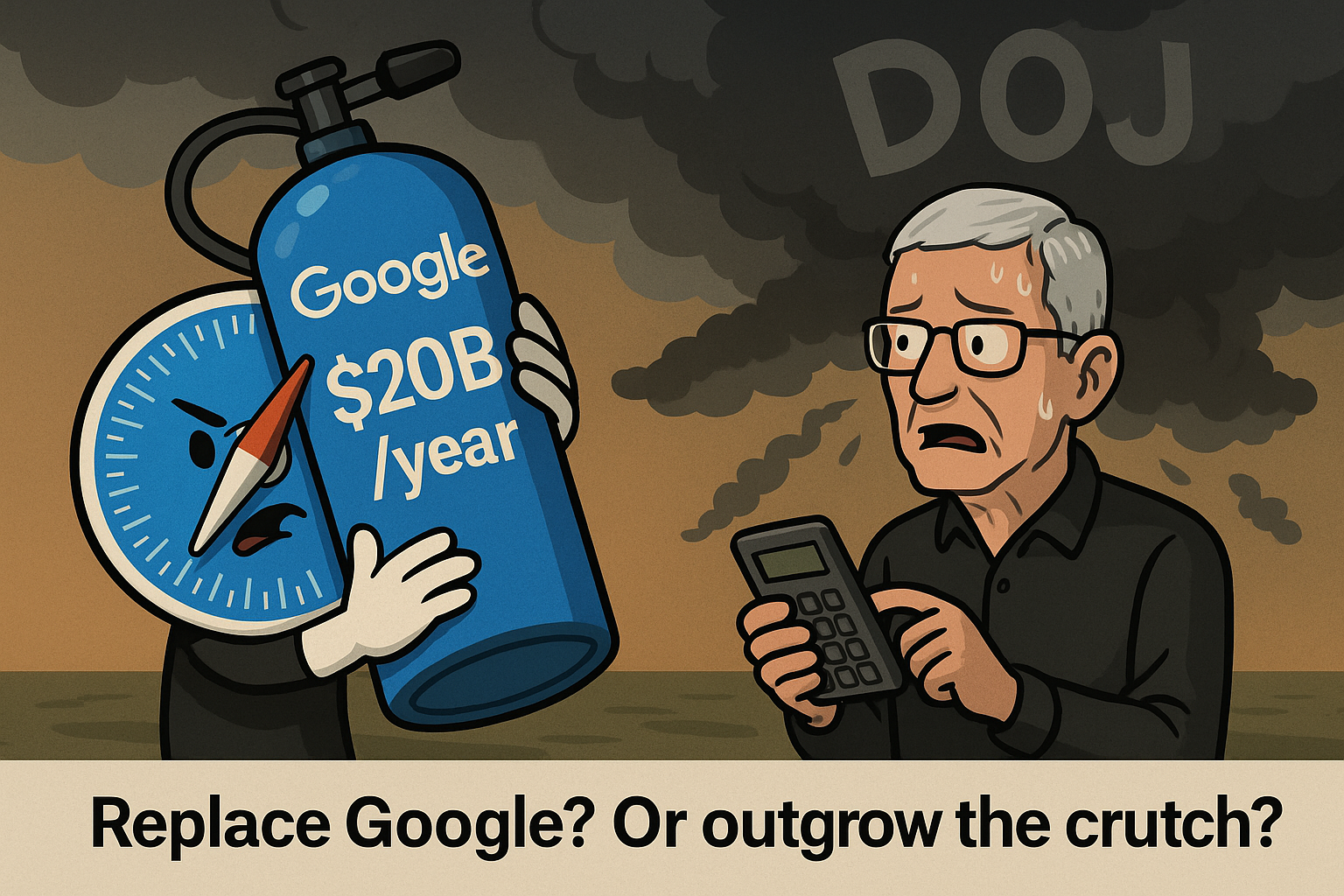
And there’s ways to monetise Perplexity straight off the bat (more on this later). The real threat is time. Apple’s FMF isn’t shipping end-to-end AI assistants yet. What they demoed was developer tooling, not a functioning Siri replacement.
If they bet only on FMF, they risk:
• Missing the consumer window (again),
• Getting leapfrogged by multi-agent interfaces from OpenAI, Google, and Meta,
• Having Siri 2.0 arrive in 2026 still trying to prove itself.
Meanwhile, Perplexity is already:
• Model-agnostic,
• Real-time,
• Reliable (enough),
• And surprisingly beloved by Gen Z and tech-adjacent power users.
So what’s the move?
Buy Perplexity. Integrate it into FMF.
• Let FMF be the back-end engine.
• Let Perplexity be the front-end prototype.
• Use it as a testbed for Siri’s reinvention.
And—like with NeXT and macOS—make the acquisition the turning point.
“This is the moment Apple stopped iterating Siri… and rebuilt it. Immediately, in 2025, and in time for this year’s iPhone launch instead of the 2026 model.”
What is my SenseOS concept and why is it relevant to Apple’s FMF?
In my formulation, SenseOS is:
“A meta-operating system that intermediates between data, devices, and intent—unifying inputs from across Apple’s ecosystem and converting them into intelligent, anticipatory action.”
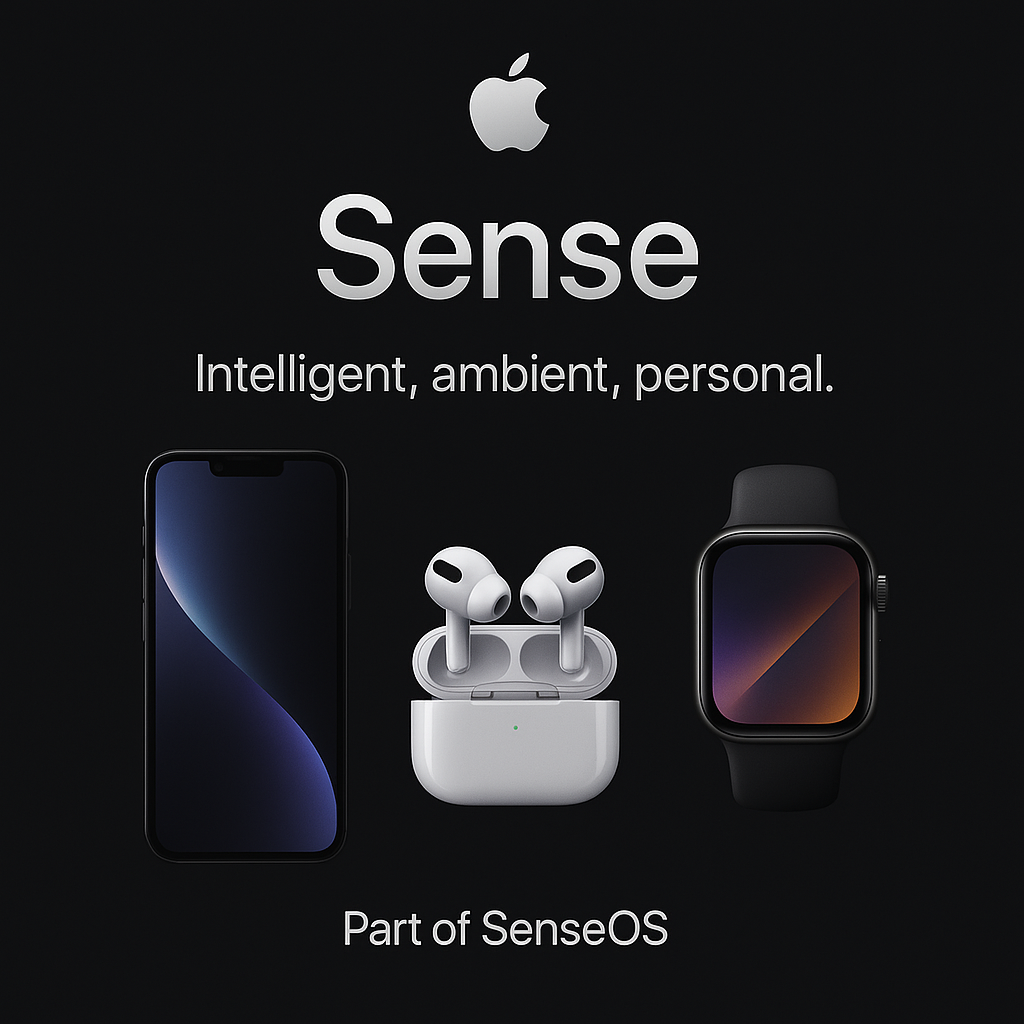
It sits above the OS level, below the UI, and orchestrates across modalities:
• Sensors (watch, phone, AirPods)
• Contextual data (calendar, location, habits)
• Health & mood signals
• Third-party apps
• Apple Intelligence APIs (FMF, SiriKit+, etc.)
The job of SenseOS is not just to answer questions. It’s to sense, adapt, and act—proactively, seamlessly, and invisibly. Perplexity could be the framework into this slots, so easily, and right now – even extending AppleAI onto other platforms, just like deploying iTunes on Windows.
By making the iPod Windows compatible and launching iTunes for Windows, Apple ended up owning the market not just for music downloads, but the hardware ultimately, as well, as people rapidly began to switch platforms - not least for MP3 players, but their laptops too. The start of the MacBook and iMac boom and the “Get a Mac” switcher campaign began. BOOM.

What is Perplexity built to do?
Not just search. Perplexity is already:
- Model-agnostic, dynamically routing across Claude, GPT, Mistral, etc
- Citation-aware, surfacing sources for trust and traceability.
- Query-router native, breaking complex prompts into sub-tasks, fetching results, reassembling answers.
- API-first, meaning it can:
- Fetch,
- Parse,
- Integrate,
- Display,
- And explain data—from multiple sources—without user friction.
In other words: it’s a real-time multi-agent OS masquerading as a search engine. And ready to replace Google right out of the box, right now, snookering Google in the process, and iterating cross-platform too in a reverse takeover.
Why this fits Apple like a glove
Apple doesn’t need another LLM. It’s already building one—FMF as the frameworks to the LLM Apple is still developing.
What Apple desperately needs is:
- A proven orchestration layer
- A fast-evolving front-end assistant UX
- An information routing architecture that matches its privacy and UX values
- Something to translate intent → action without modal dead-ends (like Siri circa 2023)
This is precisely where Perplexity shines. And unlike OpenAI, Anthropic, or Google DeepMind—it’s buildable into an OS rather than a standalone AI LLM and closed system. In other words, it’s the congregation come alive, not a church and a pulpit.
So yes—Perplexity = SenseOS-as-a-service
Think of it this way:
- FMF+AI = Apple’s LLM engine
- SenseOS concept/Perplexity = The meta-UX, orchestration, intent-routing OS, using API driven outside calls when needed.
- Perplexity = The working embodiment of that system
Buy the prototype. Train it on-device. Rewire it for Apple’s privacy-first stack. And ship Siri 3.0 not as a chatbot, but as part of the SenseOS layer, fed by Perplexity. This isn’t about a wrapper. It’s about a ready-to-integrate nervous system.
And at $15-30B, it’s a rounding error for a trillion-dollar company desperate to stop being laughed at when someone says “Hey Siri.”
SenseOS = Intent Engine
FMF = Interface Layer
Apple LLM = Still Cooking (use Perplexity’s APIs for now)
Perplexity = Drop-in Nervous System That Works Now
What Apple Already Has:
FMF (Foundational Model Frameworks):
The public-facing API scaffolding for developers to build AI-infused app features. This includes vector memory, on-device fine-tuning, privacy containers, etc.
→ Think: The roads, junctions, and speed limits.
A Walled Garden of Data:
Apple controls a deep, rich, longitudinal corpus of user context: location, biometrics, app use, preferences, and device interconnectivity.
Siri (Legacy):
A brittle command parser duct-taped to Wolfram, apps, and some CoreML smarts. It was never built to reason, route, or respond recursively.
An LLM-In-Development:
Apple’s own generative model (rumoured to be training on secure, closed Apple data) but not yet performant enough to ship publicly—especially on-device.
What Perplexity Offers Right Now:
Intent Understanding + Query Routing:
Natural language → search intent → multi-hop decompositions → structured, real-time answers.
Model-Agnostic Deployment:
It already plugs into Anthropic, GPT-4, Mistral, Mixtral, etc. This matches Apple’s “start server-side, move to on-device” plan.
Zero-Friction UX:
Perplexity’s app behaves exactly like what a reinvented Siri should feel like: fast, helpful, citation-backed, and transparent.
Modular Backend:
The entire system is already API-native, meaning it could be dropped into FMF’s spine almost overnight, acting as:
- A stand-in for Apple’s unfinished LLM and FMF combination
- A router between Apple’s own models and 3rd-party ones (while maintaining privacy boundaries)
- A proof-of-concept UX for what Siri could evolve into
The Realisation:
Perplexity offers the underpinnings right now with the streamlined API driven integration of refined access to existing models. Internaly within the Walled Garden, it’s the plumbing for the SenseOS . It’s not a LLM. It’s not a chatbot. Not a wrapper. It’s a modular, model-agnostic, privacy-aware intent engine:
· Drop it into FMF.
· Let it call 3rd-party LLMs today.
· Swap in (or add in) Apple’s LLM(s) tomorrow.
· Own the pipeline from data → intent → action, instead of renting it from OpenAI or Google, and have Apple AI deployable multi-platform.
And launch a smarter Siri today, not in Spring 2026, with all of Apple’s devices sensors and apps unified under an AI-driven search engine in the form of Perplexity to deliver that SenseOS experience to users right now, not in 12 months time or later.
OWN THE INDUSTRY IN 3 MONTHS, AFTER LAGGING IT FOR 3 YEARS. LEAVE THE COMPETITION 3 YEARS BEHIND @ WWDC2026
Where Apple is and what value Perplexity can offer.
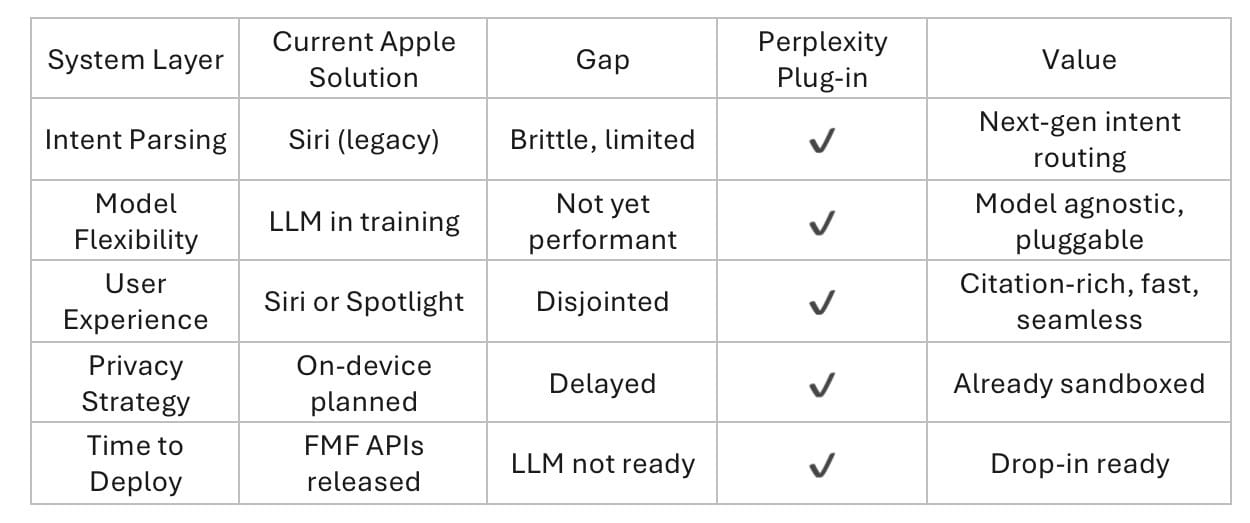
The Key Hurdles Apple Needs to Overcome to Integrate Perplexity Safely
Perplexity is not perfect. But then, neither was NeXT when Apple bought it. The key is knowing what needs tightening—and how easily Apple can do it. Here are the four core friction points, and how they can be addressed:
1. User Data & Tracking Practices
The Issue:
Out of the box, Perplexity collects IP addresses, device metadata, and user behaviour—especially when using its browser or extensions. While these are common practices across LLM platforms, they exceed Apple’s default privacy posture.
The Fix:
Apple would likely sandbox all tracking layers, require opt-in telemetry, and reconfigure data flow to conform with its strict App Tracking Transparency (ATT) and iCloud privacy relay frameworks. In short: Apple’s privacy DNA would overwrite the defaults.
2. Security Vulnerabilities in Client Apps
The Issue:
Independent audits have revealed flaws in the Android client—hardcoded keys, poor SSL handling, and CORS misconfigurations. While not core to Perplexity’s backend, these vulnerabilities weaken trust.
The Fix:
Apple’s acquisition playbook includes immediate hardening. Expect a full rebuild of mobile clients using Apple’s own secure SDKs, hardened sandboxes, and endpoint protections. It would take weeks, not years—and likely happen before any public launch.
3. Legal Risk: Unlicensed Content Scraping
The Issue:
News organisations like the BBC have raised flags about Perplexity surfacing scraped content without consent or licensing, potentially violating IP rights.
The Fix:
Apple already holds global content deals for Apple News, Podcasts, and TV. These relationships can be extended to cover AI results. Apple could also limit hallucinated source snippets and ensure only rights-cleared citations are shown—turning a liability into a trust differentiator.
4. User Data Training & Consent
The Issue:
Unless toggled off, Perplexity may use queries for model improvement—raising privacy concerns in enterprise or regulated environments.
The Fix:
Apple would make private-by-default the baseline. Any training-based telemetry would require explicit opt-in with full auditability—bringing Perplexity in line with iCloud Private Relay, App Privacy Reports, and its new FMF developer rules.
5. The One Disturbing Factor
Let’s not dodge the elephant in the room. The most serious critique of a potential Perplexity acquisition is this:
“It has no moat. No core LLM. No crawler infrastructure. No proprietary IP. Just a polished wrapper and some historical controversy about its delivery methods”
I’m sure Apple’s due diligence testing would uncover the truth about glaring problems with Perplexity which were unfixable long before the ink dry on a deal, but let’s put that love/hate argument to one side for now on the assumption for this discussion that Perplexity is more than just a clever piece of plumbing (which isn’t entirely wrong, but that’s like comparing a tap to the Hoover Dam):
Perplexity is not OpenAI. It’s not Gemini. It doesn’t own the models. It doesn’t index the entire web. It doesn’t even pretend to. It orchestrates. It wraps. It routes. It summarises. And yes—someone else could clone that UX shell.
The Fix:
Apple’s acquisition playbook includes full client hardening.
Expect a rebuild using Apple’s own SDKs, sandboxes, and endpoint security standards. A few weeks of engineering—not years—would fix this long before public rollout.
Apple would sandbox tracking layers, enforce opt-in telemetry, and reroute data flows under its App Tracking Transparency (ATT), iCloud Private Relay, and on-device inference frameworks together with anonymising user data for outside LLM queries.
Apple’s privacy architecture would overwrite Perplexity’s defaults, not the other way around.

So why would Apple gamble between $15-30B on something that looks, to some, like “just a pretty interface” sitting atop rented smarts?
Because Apple is out of time. They don’t need to own the entire LLM universe—they need to deliver coherence across it. They don’t need a search engine. They need an AI surface. And Perplexity, imperfect though it may be, is the only company today that:
· Is LLM-agnostic and already routing across multiple models
· Has a UX ethos almost indistinguishable from Apple’s own
· Can be shipped tomorrow with minimal integration delay
· And crucially: doesn’t try to become the star of the show
In other words:
It’s a rare startup that would amplify Apple’s platform—not compete with it, and easily integrate with Apple’s own LLMs when they’re ready, with safeguards in the meantime. Could it become redundant in 2–3 years? Maybe.
But in the next 12–18 months, it could unlock everything Apple has been trying—and failing—to do with Siri and AI since 2018 onwards, and especially since AI went full on Space-X vertical in 2023. The win is not infinite defensibility. The win is immediate orchestration. That buys Apple time, trust, and talent, and frees up its existing resources to immediately get back to work on other vital project long neglected.
Bridges cross chasms. Castles get sieged.
If Perplexity is a bridge, not a castle—so be it. Bridges are how you cross chasms, and Apple has allowed several big ones to crack wide open around it.

Conclusion:
None of these issues are terminal. All are solvable with Apple and Perplexity’s engineers working together, and Apple’s privacy-first philosophy. And unlike Siri, which started with limitations baked in, Perplexity starts fast, agile, and open—making it a rare case of an acquisition that Apple could both clean up and level up and integrate immediately.
They could do this by the time of this year’s iPhone release if they chose..This isn’t a rescue. It’s a retrofit. And it’s ready. If Apple chooses to ship.
Summary: Perplexity is not an LLM either. It’s a wrapper. A perfect fit, for now, and a fuss worth paying for.
A beautifully engineered orchestrator that sits above several best-in-class models (GPT, Claude, etc) and manages how they’re queried, how results are validated, how hallucinations are avoided, and how user context is remembered (temporarily or permanently, depending on settings).
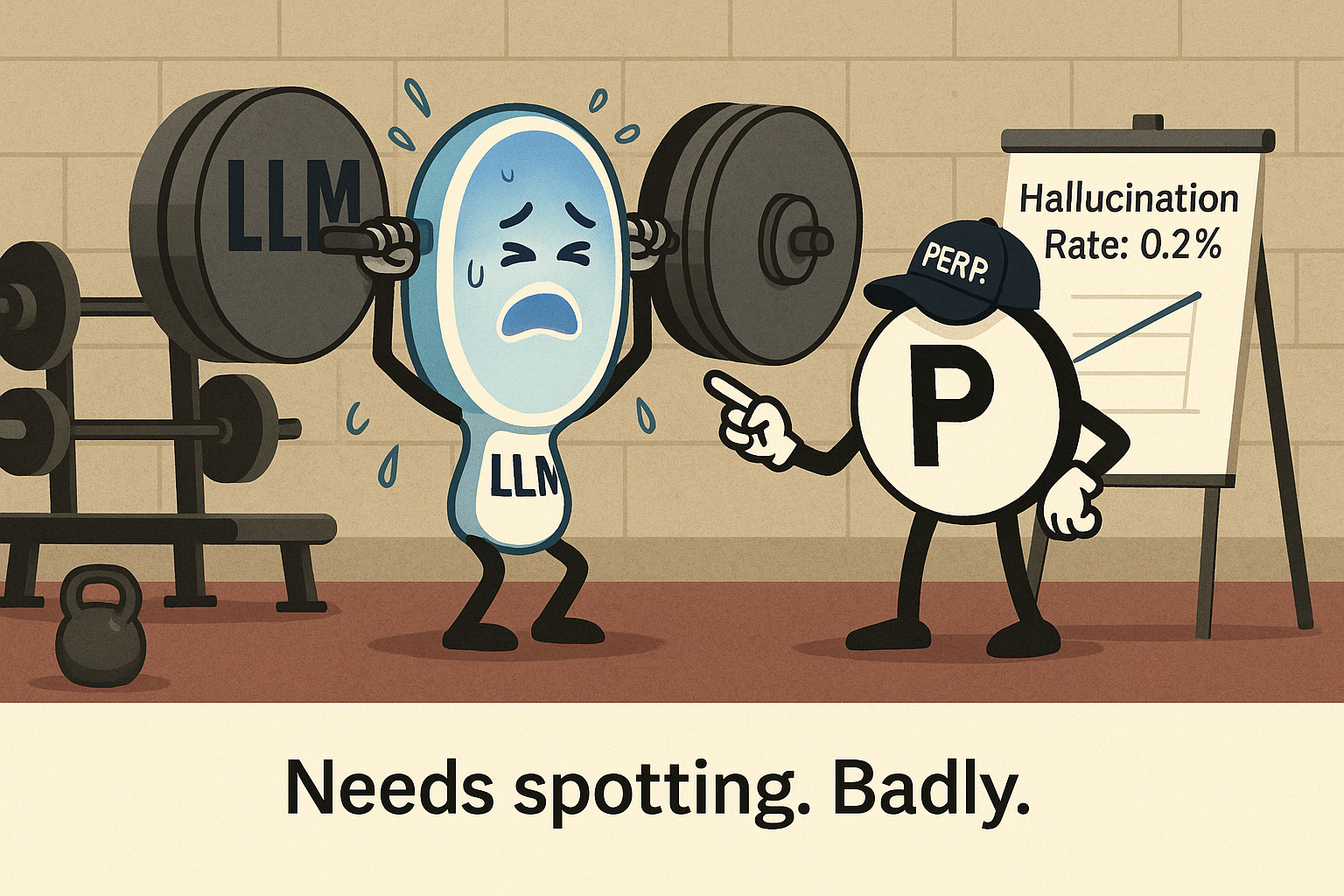
Perplexity reduces hallucinations by combining real-time web search with large language models, feeding live, verifiable data into the prompt before generating a response. Unlike raw LLMs, it routes queries to the best-suited model, cites sources, and cross-validates facts. The result? Faster, sharper, and far less prone to making things up. It’s not perfect, but it’s a lot better than any single LLM out there and with citations given, you can check your results if it’s mission critical.
That is what FMF + Apple’s LLM is meant to do. But FMF isn’t live yet. Perplexity is, and can work within Apple’s already existing and published FMF API’s making it deployable immediately. It even talks, if you want a chatbot.
What Perplexity offers Apple isn’t “better AI” than what Apple’s building—it’s a working version of everything Apple hasn’t finished yet. It mirrors Apple’s architectural direction almost uncannily, but right now, with certainty.
• Clean, privacy-forward routing
• Intent awareness.
• Agent-style multi-query handling
• Seamless handoff across modalities (text/image/web)
• UI discretion that disappears behind the experience
Drop Perplexity in as a temporary engine—or even a permanent layer—and suddenly FMF has a brain. Siri has purpose. The device mesh can talk to itself. The waiting is over. SenseOS is alive. Developers can ship.
And while Apple’s own LLM model cooks, everything else still moves forward..
… so, now back, to what I was about to conclude in my opening paragraph to this article:
“Apple should buy Perplexity. Fully. Cleanly. Now.”
Engineers, stack, ethos, the lot. Not as a bolt-on. As a foundation. Spend the $15-30B like it’s 1997 and they’re buying NeXT all over again because that’s what this could be: the OS X of Apple’s AI future.
Move on from 1995. It’s 2025 now. It’s time to start selling Apple Service to non-Apple customers, and build up that installed user base again. In 2004 Apple sold iPods to Windows users. In 2025, Apple could be selling AI to Android users.
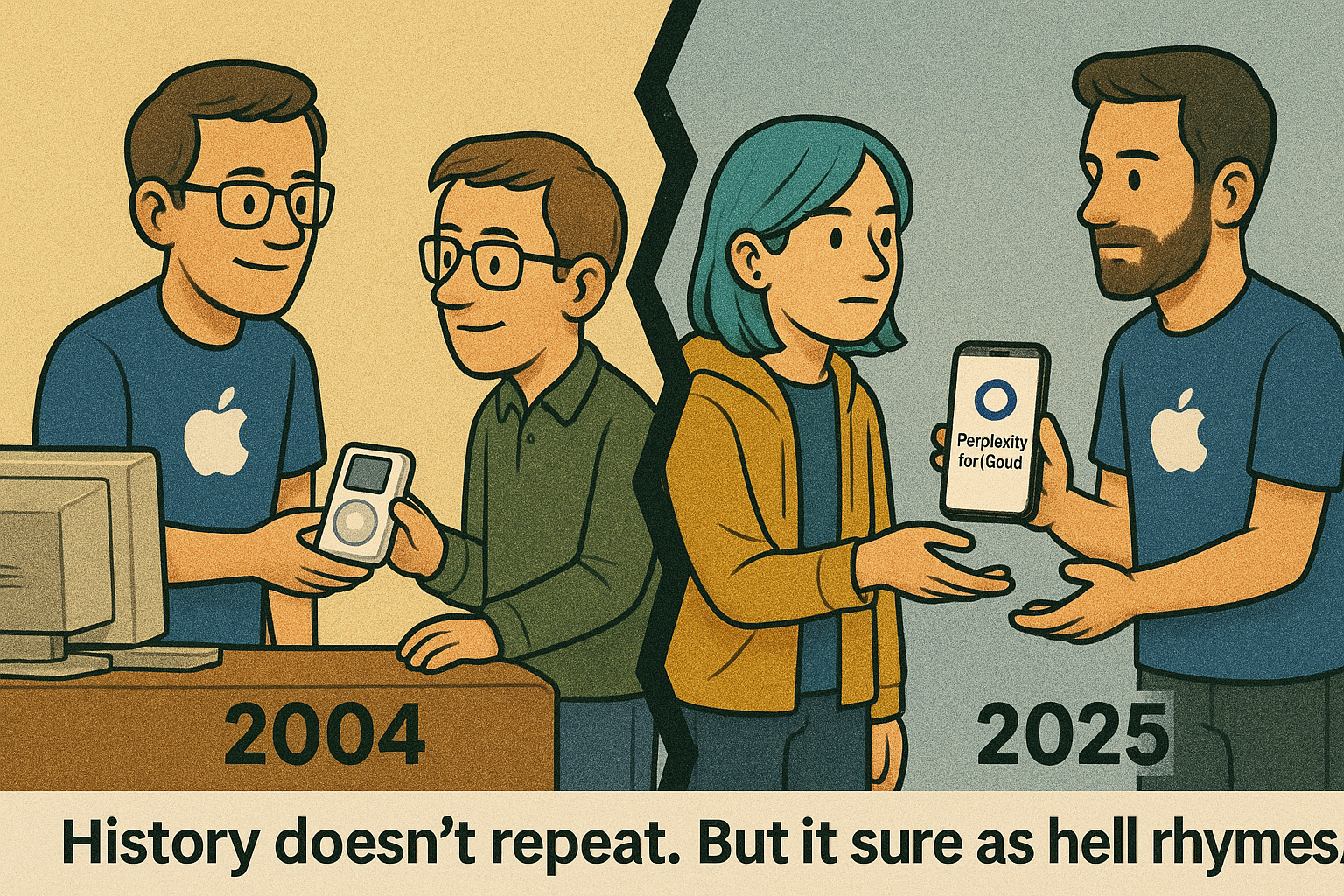
Here’s a “Foundational Model Future” vision for Apple’s execution instead of gingerly hoping it will “all work out in the end” with disaster looming if they don’t, why not assure that future, as Apple did when it bought in NeXT OS and Jobs?
Right now. And leapfrog all of its competitors by owning the entire industry in breadth, and depth, and deployment, allowing Apple AI to be run on other platforms, but not shared within the privacy and security of the Apple ecosystem walled garden.
Benediction —the “Show Me The Money” moment: The Return of “One More Thing.”
“Some people say, ‘Give the customers what they want.’ But that’s not my approach. Our job is to figure out what they’re going to want before they do. I think Henry Ford once said, ‘If I’d asked customers what they wanted, they would’ve told me “a faster horse.”’ People don’t know what they want until you show it to them.”
– Steve Jobs in an interview with BusinessWeek, 1998
Perplexity is platform agnostic. It is API driven. It gets a lot of flack for that and has a recent history of extraordinary controversy. So did Apple when it launched the Lisa and the Macintosh, and as for charges of building on the success of others by not having its own LLM? I can think of someone who went to Xerox Parc and took all their best and most innovative ideas, to build the Lisa GUI from it.
Pirates indeed! In so many ways and in some counter-intuitive manner, it fits. It fits right into the Apple AI ecosystem - and here’s the kicker:
“It does not have to be locked down for Apple users only.”
Perplexity as an Apple Services product
Perplexity has a loyal and very large following of users.
Why not allow it to be accessed via an iCloud subscription for non-Apple device users, and gain the benefits of access to all of Apple’s services, and spreading the appeal of an Apple Service bundle to everyone and everywhere on every platform, because those services are platform agnostic, just like Perplexity, and could extend Services revenues to” Infinity and Beyond” – also re-igniting the “Switch” metaphor of the iPod and the iPhone which triggered the mass migration of Windows PC users to “Get a Mac” buyers after using iTunes for Windows and buying an iPod.
“Perplexity becomes the ghost in the Apple machine — not a takeover, not a trophy, but an embodiment of what Apple’s own frameworks aspire to be.
And other implementations AI on other platforms? Slowly relegated into irrelevance, just as every other MP3 player and music download system was eventually smothered to death by the cross platform availability of the iPod and iTunes for Windows, and the mass-switching which resulted to the Mac, in time for Apple to have an enormously interested and captured market and ecosystem by the time the iPhone launched.
Because with Apple’s FMF API’s available to developers outside of Apple’s platform, and therefore providing the only way into the security of the Walled Garden for Services which want to offer something to Apple device & Services users, Apple AI becomes the only platform through which to securely service all users, on all platforms, not just Apple device users. It becomes the industry default, much like the iPod and iTunes did 20 years ago, driven by Perplexity‘a already built and up and running integration with the best LLMs right now, and working on platform agnostic web platforms, web apps and SDK produced apps on almost all platforms.
And before the usual suspects start to whine about Privacy, Apple Absolutism Über Alles, Siri being DOA, and yet again moan about CapEx even while cheering the money and time wasted and poured into the non-delivered Car project and car-crashed AR/VR endeavours, consider this:
1. Re: “Perplexity doesn’t have to be locked down”
Does this trip your alarm? Consider:
“Apple could retain platform openness for Perplexity’s core experience—much like Apple Music and iCloud—but reserve deeper system-level integrations for Apple hardware users. The moat remains. The reach expands.” - Boom.
2. Re: “Siri has purpose”
Siri’s track record is radioactive. But consider:
“Siri becomes less a voice assistant, more a contextual avatar—backed by live orchestration and intent-aware query management. A role it was born to play in 2010 but never trained for. Until now.” - Boom.
3. Re: “Alert: Walled Garden Privacy Breach!”
Data protection – yes I get it. Perplexity gets it too. Consider:
“Perplexity’s current architecture respects source citation and data minimisation by default. Apple’s acquisition would harden that even further—ensuring that what’s shared stays private, and what’s queried is traceable.” - Boom.
4. Re: $30B “pffft… not worth paying for. Wasted money!”
“Whatever.” You love Apple’s Free Cash Flow and want it to do something sensible with it? How about launching an earnings growth blockbuster strategy and seeing real earnings rocket, not manicured from buybacks?
“Apple spends abut $80B a year on stock buybacks. This isn’t CapEx—it’s a catalytic asset. A $30B investment in future defensibility, developer goodwill, and real-time AI legitimacy.”
“Priceless.”
Apple doesn’t need to control AI. It just needs to curate the experience, own the orchestration, and protect the trust. Perplexity lets it do all three—right now in 2025, not in 2026.
By 2026, it could own AI and LLM delivery across the industry in probably the biggest comeback story of our time. Because the last time was when Steve Jobs returned with OS X and launched the iPod. This is not just strategy. This is delivery. This is execution. This is “Real Artists Ship.”
Because, as a reminder of last week’s Sunday Sermon when I repeated and explained Steve Jobs’ laser-like obsession to shipping and in Apple’s current fear of imperfection—the endless runway Siri has been given to taxi but never take off in 15 years, this analogy now rhymes beautifully.
Quick refresh from last week: In 1984, the perfectionists on the Macintosh team delayed the Mac until Jobs said, “Enough.” Steve Jobs to Bud Tribble, one of the key Macintosh architects, while his designers fiddled with perfecting icons.
1984: A reminder of “Real Artists Ship” – The Origin Story
Vision Pro this in your mind’s eye: It’s late 1983, creeping into 1984. The original Macintosh team is exhausted, behind schedule, and feeling the gravitational pull of feature creep. They’re perfectionists. They’re obsessed. And they’re scared—scared to ship something that wasn’t ready.
Bud Tribble, one of the key software architects of the Macintosh, is in Jobs’ office. He’s pushing back on the proposed ship date, arguing that the team needs more time to finish a few features. Jobs, impatient, stops cold.
“Real artists ship,” he summarised it.
Just three words. But it landed like a thunderclap across the team. It wasn’t a dismissal of perfection. It was a demand that artistry be coupled with execution. With momentum. With market impact. Because vision is worthless if you never get it into the hands of users. Jobs wasn’t asking them to lower their standards. He was reminding them that perfection, endlessly deferred, is just fear with a better costume.
1984: Jobs’ skunkworks Macintosh team stopped fiddling, and shipped.
1997: Apple stopped fumbling OS9 rewrites and just bought NeXT.
2025: the same logic applies: Perplexity is the Mac. Perplexity is NeXT. Perplexity is ready.
And if Apple still can’t decide? Then maybe it’s time someone inside reminds the C-suite: “Real artists ship.”
“One More Thing”-The Ghost In The Machine
This is what would turns vision into value. And it doesn’t need a $4000 headset. Readers have asked me for 9 months how how AAPL could get to $400 by 2027. Well, this is how.
Buy Perplexity, plumb it it in. Put in your safeguards, connect its APIs to the FMFs which developers already have.
Hook it into Siri. Launch in time for this year’s iPhone release.
Watch the mythical super-cycle return, and open up Perplexity as part of an Apple Services bundle in a platform agnostic manner, enabling carefully curated and manicured APIs to cross between the outside world and the Apple’s ecosphere safely.
Make Perplexity and its existing APIs to the outside world the plumbing to connect to the Walled Garden and Apple Device users and sell it as a service to the world as part of an Apple One subscription including all the usual benefits, plus Perplexity Pro access in addition to the “special sauce” of Apple AI included, so Perplexity can also draw on Apple’s own LLM by API.
Apple AI – Intelligence as a platform-agnostic Service. Available now, in 2025. Now put that in your spreadsheet and start your engines, because the sky’s the limit, and so would be PE multiple.
“And that’s how Apple gets to $400 by 2027.’
Like this? Want Apple to sit up and take note?
Send it to Tim Cook. Send it to CNBC. Send it to Bloomberg. Send it to Apple Investor Relations. Send it to Gene Munster. Send it to your mother. Send it to Cramer. Send it to Jon Stewart. Just click one of the action buttons on the sidebar or the base of the screen depending on your device.
But most of all re-read it, because this isn’t techno-fetishism or shareholder fantasy. It’s a clear roadmap justified in historical context and the current climate and environment and ever-changing technological landscape, and it skates to where the puck will be, not where it was in 2023.
In fact, it makes sure Apple owns not just the puck, but the whole ice rink and the entire arena. The “Walled Garden” now has a new Stadium attached.
This is what Apple could do, right now, tomorrow.
If they can’t and won’t, the public, and investors must ask: “why won’t they ship?”
.fyi “The Sunday Service” is now over.
- Tommo_UK, London, 22nd June 2025
Please, share this newsletter with your friends, colleagues, wealth advisor or liquidator - whatever is your poison - or friendly CNBC anchor. Brian Sullivan, are you still reading?




